Broadcom BRCM1044 802.11g Wireless LAN + BluetoothPCI-E Mini Card User Manual 2
Broadcom Corporation 802.11g Wireless LAN + BluetoothPCI-E Mini Card 2
Broadcom >
Contents
User Manual 2

HP Mini User Guide

© Copyright 2010 Hewlett-Packard
Development Company, L.P.
Bluetooth is a trademark owned by its
proprietor and used by Hewlett-Packard
Company under license. SD Logo is a
trademark of its proprietor. Microsoft and
Windows are U.S. registered trademarks of
Microsoft Corporation.
The information contained herein is subject
to change without notice. The only
warranties for HP products and services are
set forth in the express warranty statements
accompanying such products and services.
Nothing herein should be construed as
constituting an additional warranty. HP shall
not be liable for technical or editorial errors
or omissions contained herein.
First Edition: April 2010
Document Part Number: 595903-001
Product notice
This user guide describes features that are
common to most models. Some features
may not be available on your computer.
To obtain the latest information in the Mini
User Guide, go to the HP Web site at
http://www.hp.com/support.

Safety warning notice
WARNING! To reduce the possibility of heat-related injuries or of overheating the computer, do not
place the computer directly on your lap or obstruct the computer air vents. Use the computer only on
a hard, flat surface. Do not allow another hard surface, such as an adjoining optional printer, or a soft
surface, such as pillows or rugs or clothing, to block airflow. Also, do not allow the AC adapter to
contact the skin or a soft surface, such as pillows or rugs or clothing, during operation. The computer
and the AC adapter comply with the user-accessible surface temperature limits defined by the
International Standard for Safety of Information Technology Equipment (IEC 60950).
iii
iv Safety warning notice

Table of contents
1 Getting started ................................................................................................................................................ 1
Slate Home ........................................................................................................................................... 2
Navigating the Home screen ................................................................................................................ 3
Top bar controls ................................................................................................................... 3
Content area controls .......................................................................................................... 4
Toolbar controls ................................................................................................................... 4
2 Using Slate Home ........................................................................................................................................... 5
Using Slate Camera ............................................................................................................................. 6
Using Slate Music ................................................................................................................................. 7
Using Slate Photo ................................................................................................................................. 8
Using Slate Video ................................................................................................................................. 9
3 Knowing the parts ......................................................................................................................................... 10
Identifying the hardware ..................................................................................................................... 10
Front components .............................................................................................................. 10
Rear components .............................................................................................................. 10
Right-side components ...................................................................................................... 11
Left-side components ........................................................................................................ 12
Display components .......................................................................................................... 12
Bottom components ........................................................................................................... 13
Wireless antennas ............................................................................................................. 13
Identifying the labels ........................................................................................................................... 14
4 Power management ...................................................................................................................................... 15
Setting power options ......................................................................................................................... 15
Using power-saving states ................................................................................................. 15
Initiating and exiting Sleep ................................................................................ 15
Initiating and exiting Hibernation ....................................................................... 16
Using power plans ............................................................................................................. 16
Viewing the current power plan ......................................................................... 16
Selecting a different power plan ........................................................................ 16
Customizing power plans .................................................................................. 16
v
Setting password protection upon exiting Sleep or Hibernation ........................................ 17
Using external AC power .................................................................................................................... 17
Connecting the AC adapter ............................................................................................... 18
Using battery power ........................................................................................................................... 18
Displaying the remaining battery charge ........................................................................... 19
Finding battery information in Help and Support ............................................................... 19
Using Battery Check .......................................................................................................... 19
Charging a battery ............................................................................................................. 19
Maximizing battery discharge time .................................................................................... 20
Managing low battery levels .............................................................................................. 20
Identifying low battery levels ............................................................................. 20
Resolving a low battery level ............................................................................. 21
Resolving a low battery level when external power is available ....... 21
Resolving a low battery level when a charged battery is available ... 21
Resolving a low battery level when no power source is available .... 21
Resolving a low battery level when the computer cannot exit
Hibernation ....................................................................................... 21
Calibrating a battery ........................................................................................................... 21
Step 1: Fully charge the battery ........................................................................ 21
Step 2: Disable Hibernation and Sleep ............................................................. 22
Step 3: Discharge the battery ............................................................................ 22
Step 4: Fully recharge the battery ..................................................................... 23
Step 5: Reenable Hibernation and Sleep .......................................................... 23
Conserving battery power .................................................................................................. 23
Shutting down the computer ............................................................................................................... 24
5 Internet ........................................................................................................................................................... 25
Connecting to a wireless network ....................................................................................................... 26
Using wireless devices ...................................................................................................... 26
Identifying wireless and network icons .............................................................. 26
Using the wireless controls ............................................................................... 27
Using the wireless action key ............................................................................ 27
Using HP Connection Manager (select models only) ........................................ 27
Using Wireless Assistant software .................................................................... 27
Using operating system controls ....................................................................... 28
Using a WLAN ................................................................................................................... 28
Setting up a WLAN ............................................................................................ 29
Protecting your WLAN ....................................................................................... 29
Connecting to a WLAN ...................................................................................... 30
Roaming to another network ............................................................................. 31
Using HP Mobile Broadband (select models only) ............................................................................. 32
Inserting a SIM ................................................................................................................... 32
Removing a SIM ................................................................................................................ 33
Using Bluetooth wireless devices ....................................................................................................... 35
vi
Bluetooth and Internet Connection Sharing (ICS) ............................................................. 35
6 Multimedia ..................................................................................................................................................... 36
Multimedia features ............................................................................................................................ 36
Identifying your multimedia components ........................................................................... 36
Adjusting the volume ......................................................................................................... 37
Multimedia software ........................................................................................................................... 37
Using preinstalled multimedia software ............................................................................. 38
Installing multimedia software from the Internet ................................................................ 38
Audio .................................................................................................................................................. 39
Connecting external audio devices .................................................................................... 39
Checking your audio functions ........................................................................................... 39
Video .................................................................................................................................................. 41
Webcam ............................................................................................................................................. 42
7 Security .......................................................................................................................................................... 43
Protecting the computer ..................................................................................................................... 43
Using passwords ................................................................................................................................ 43
Setting passwords in Windows .......................................................................................... 44
Setting passwords in Setup Utility ..................................................................................... 44
Administrator password ..................................................................................... 45
Managing an administrator password ............................................... 45
Entering an administrator password ................................................. 45
Power-on password .......................................................................................... 45
Managing a power-on password ...................................................... 46
Entering a power-on password ......................................................... 46
Using antivirus software ..................................................................................................................... 47
Using firewall software ....................................................................................................................... 48
Installing critical updates .................................................................................................................... 49
8 Digital cards .................................................................................................................................................. 50
Inserting a digital card ........................................................................................................................ 50
Removing a digital card ...................................................................................................................... 51
9 USB devices .................................................................................................................................................. 52
Using a USB device ........................................................................................................................... 52
Connecting a USB device .................................................................................................. 52
Removing a USB device .................................................................................................... 52
10 Pointing devices, touch screen, and keyboard ........................................................................................ 54
Using pointing devices ....................................................................................................................... 55
Setting pointing device preferences ................................................................................... 55
vii
Using the touch screen ....................................................................................................................... 56
Using touch screen gestures ............................................................................................. 56
Tapping ............................................................................................................. 56
Flicking .............................................................................................................. 56
Dragging ............................................................................................................ 56
Scrolling ............................................................................................................ 57
Rotating ............................................................................................................. 57
Pinching ............................................................................................................ 58
Setting touch screen preferences ..................................................................... 59
Navigating the keyboard utility ........................................................................................................... 60
Using the action keys ......................................................................................................................... 61
Using the hotkeys ............................................................................................................................... 63
11 Drives ........................................................................................................................................................... 64
Identifying installed drives .................................................................................................................. 64
Handling drives ................................................................................................................................... 64
Using external drives .......................................................................................................................... 65
Using optional external devices ......................................................................................... 65
12 Updating software ....................................................................................................................................... 66
Updating the BIOS ............................................................................................................................. 67
Determining the BIOS version ........................................................................................... 67
Downloading a BIOS update ............................................................................................. 67
Updating programs and drivers .......................................................................................................... 69
13 Setup Utility ................................................................................................................................................. 70
Starting Setup Utility ........................................................................................................................... 70
Using Setup Utility .............................................................................................................................. 70
Changing the language of Setup Utility ............................................................................. 70
Navigating and selecting in Setup Utility ............................................................................ 70
Displaying system information ........................................................................................... 71
Restoring default settings in Setup Utility .......................................................................... 71
Exiting Setup Utility ............................................................................................................ 71
Setup Utility menus ............................................................................................................................ 72
Main menu ......................................................................................................................... 72
Security menu .................................................................................................................... 72
System Configuration menu .............................................................................................. 72
Diagnostics menu .............................................................................................................. 73
Index ................................................................................................................................................................... 74
viii

1 Getting started
Your computer's main operating system is Microsoft® Windows® 7 Premium. Your computer also
features HP TouchSmart Slate Home software.
●The Microsoft Windows operating system displays the desktop on the display and controls your
computer's hardware, peripherals, and software programs.
●HP Touchsmart Slate Edition allows you to quickly browse the Internet, capture still photos,
record video, listen to music, or keep in touch using e-mail, instant messages, or Skype.
1

Slate Home
Use Slate Home for all your favorite things:
●Searching and browsing the Internet, opening bookmarks, and creating links to your favoriteWeb
sites.
●Listening to your favorite music and creating links to your favorite albums and playlists.
●Viewing your photos and creating links to your favorite photo albums.
●Accessing all of the programs and settings installed on HP TouchSmart Slate Edition.
●Accessing the software Help.
To start Slate Home from Microsoft Windows:
1. Tap the Home icon.
– or –
2. You can also access Slate Home by pressing the Home button on the top edge of the Slate.
– or –
3. Turn on your computer.
4. Tap Start > HP > Slate Home
5. Tap an icon on the Slate Home screen to launch a program.
NOTE: To learn more about Slate Home, refer to the software Help.
2 Chapter 1 Getting started
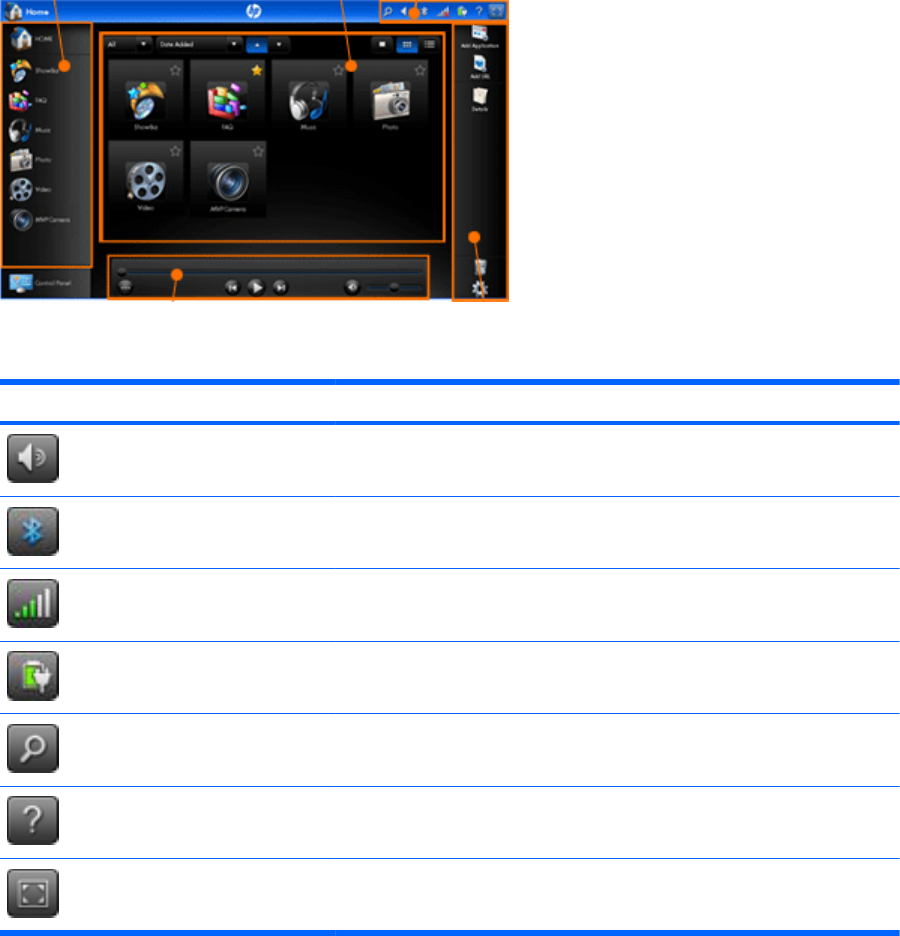
Navigating the Home screen
The Home Screen is divided into four sections:
●Top Bar—Accesses the different areas of the Home Screen.
●QuickLaunch—Adds your favorite URLs or applications to Quick Launch for quick access. You
can arrange them as you like.
●Content Area—Displays all of your applications and URLs.
●Toolbar—Displays special function buttons for each application.
Top bar controls
Icon Description
Volume Controls system volume.
Bluetooth Displays available Bluetooth devices.
WiFi Displays available WiFi connections and allows you to select one.
Power Displays the power status.
Search Searches all files in Slate Home.
Help Displays the help for Slate Home.
Full screen Switches to full screen mode.
Navigating the Home screen 3
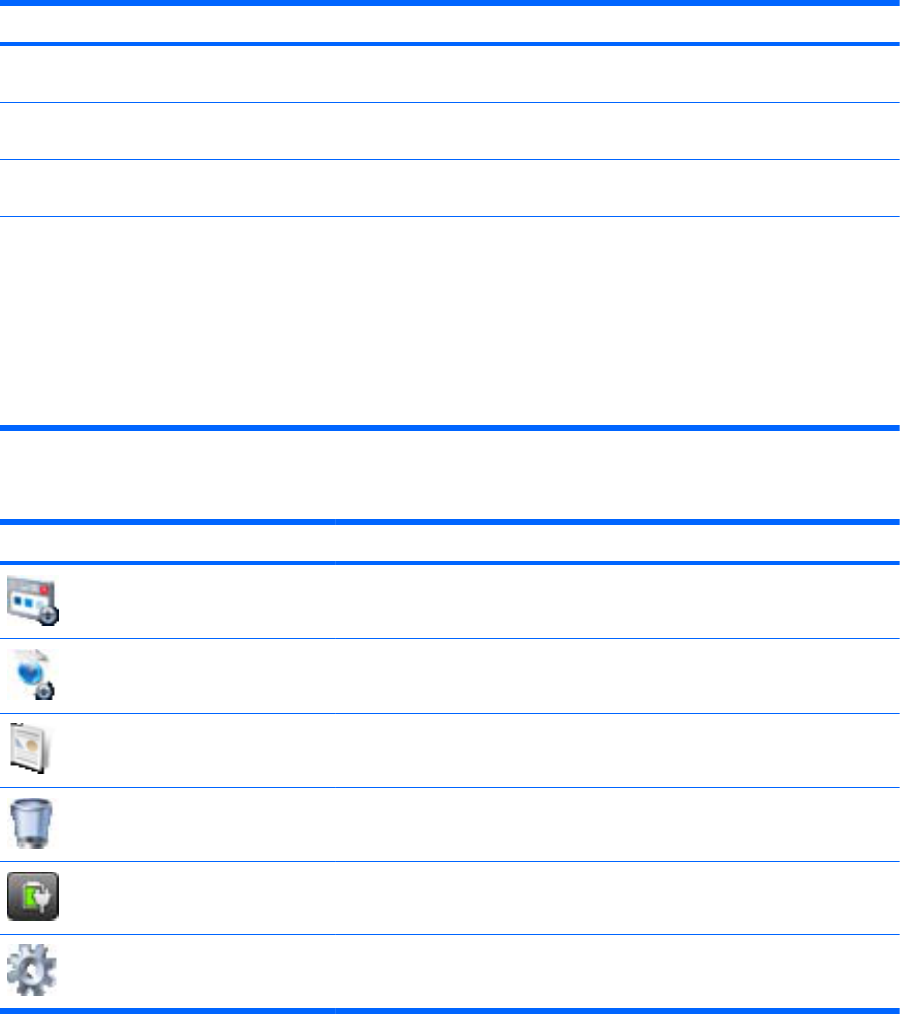
Content area controls
Control Description
Set a favorite mark Tap the star on an item’s frame to set it as a favorite. You can also set a favorite mark on the item’s
Details page.
Launch an
application
Tap an icon to access a URL or launch an application.
Display the Flip
menu
2-finger flip an icon or tap the arrow on an icon to display brief details for the item. Tap the star to set
a favorite for the item.
Display the Service
menu
1-finger long press an icon to display the Service Menu, which provides the following quick
operations:
●Launch—Launches an application or URL.
●Add to Quick Launch—Adds this item to the Quick Launch area.
●Remove—Moves the item to Trash Can.
●Details—Displays the details for this item.
Toolbar controls
Icon Description
Add applications Adds applications to the Home Screen. You can also set parameters for the
application or change the name..
Add URL Adds URLs to the Home Screen. You can also create names for your URLs.
Details view Displays the Details View. Tap the white text to view or edit the information
about the item. You can also set it as a favorite.
Trash can Stores the removed applications and URLs. You can restore or permanently
delete them.
Power Displays the power status.
Settings Customizes your configuration..
4 Chapter 1 Getting started

2 Using Slate Home
You can use Slate Home to launch the following programs:
●Camera—Take snapshots and videos with the outward or inward camera.
●Music—Listen to your favorite music and create playlists.
●Photo—Browse through your photos, create albums, view slide shows, and publish your photos
online.
●Video—Play videos, crate playlists, and publish your videos online.
●Web browser—Search and browse the Internet with the FireFox Web browser, and create links
to your favorite Web sites.
5
Using Slate Camera
You can take snapshots and record videos with either the outward or the inward webcam. To start the
Camera application, tap the Camera icon in the Quick Launch area of Slate Home.
For more information about the Camera application, refer to the software Help.
6 Chapter 2 Using Slate Home
Using Slate Music
You can use Music software to play all of your music and create individual playlists. You can also
select cover images, rate your music, and edit the descriptions. To start the Music application, tap the
Music icon in the Quick Launch area of Slate Home.
For more information about the Music application, refer to the software Help.
Using Slate Music 7
Using Slate Photo
You can use Photo software to organize your photos and create slideshows. You can also upload
your photos to popular photo Web sites, such as Snapfish, Flickr, and FaceBook. To start the Photo
application, tap the Photo icon in the Quick Launch area of Slate Home.
For more information about the Photo application, refer to the software Help.
8 Chapter 2 Using Slate Home
Using Slate Video
You can use Video software to organize your videos and create slideshows. You can also upload
your videos to YouTube. To start the Video application, tap the VIdeo icon in the Quick Launch area
of Slate Home.
For more information about the Video application, refer to the software Help.
Using Slate Video 9
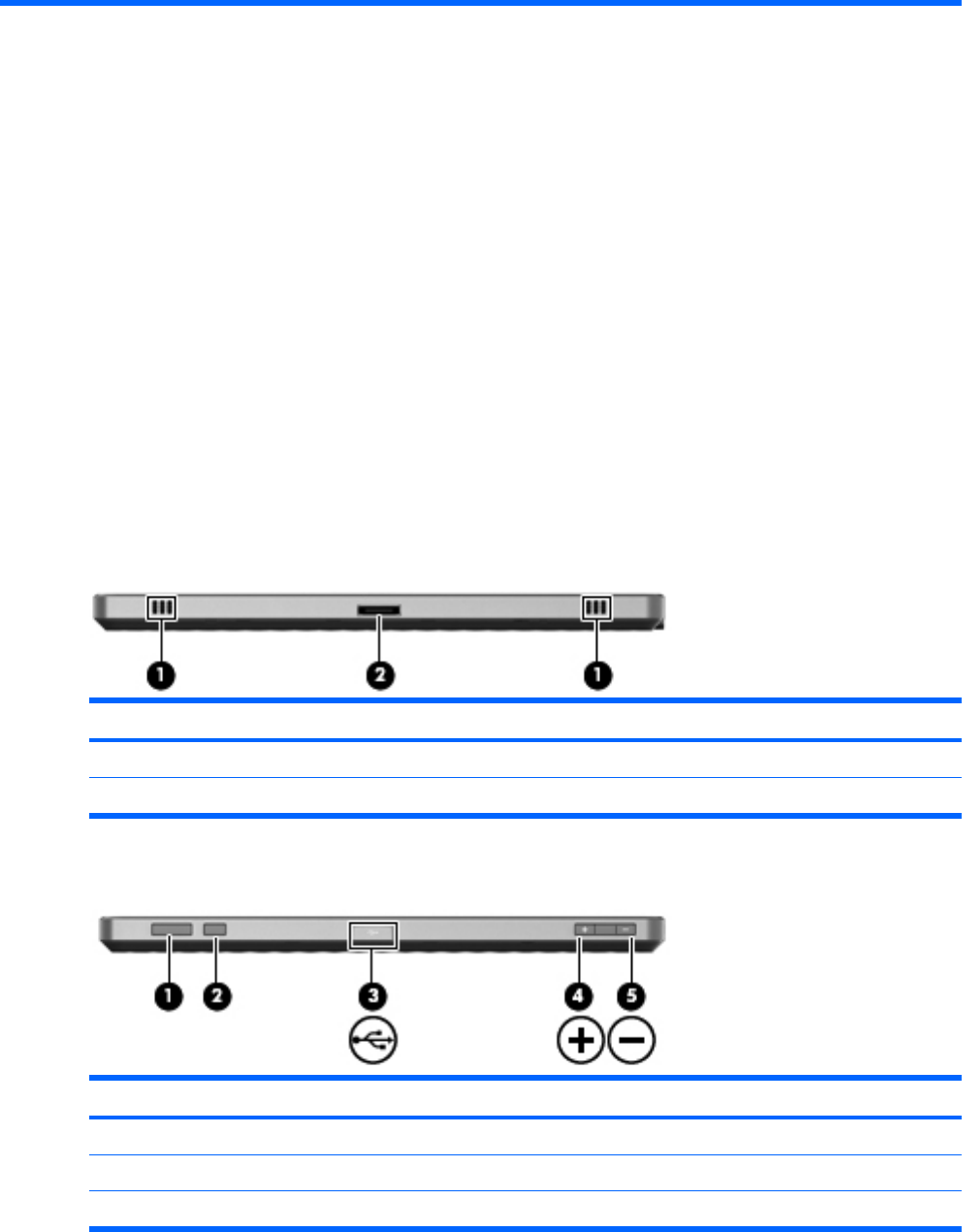
3 Knowing the parts
Identifying the hardware
Components included with the computer may vary by region and model. The illustrations in this
chapter identify the standard features on most computer models.
To see a list of hardware installed in the computer:
▲Tap Start > Control Panel > System and Security. Tap System, and then tap Device
Manager.
You can also add hardware or modify computer configurations using Device Manager.
Front components
Component Description
(1) Vents (2) Enables airflow to cool internal components.
(2) Power connector Connects an AC adapter.
Rear components
Component Description
(1) Home button Displays the Slate Home screen.
(2) Keyboard button Displays the virtual keyboard.
(3) USB ports (2) Connect optional USB devices.
10 Chapter 3 Knowing the parts
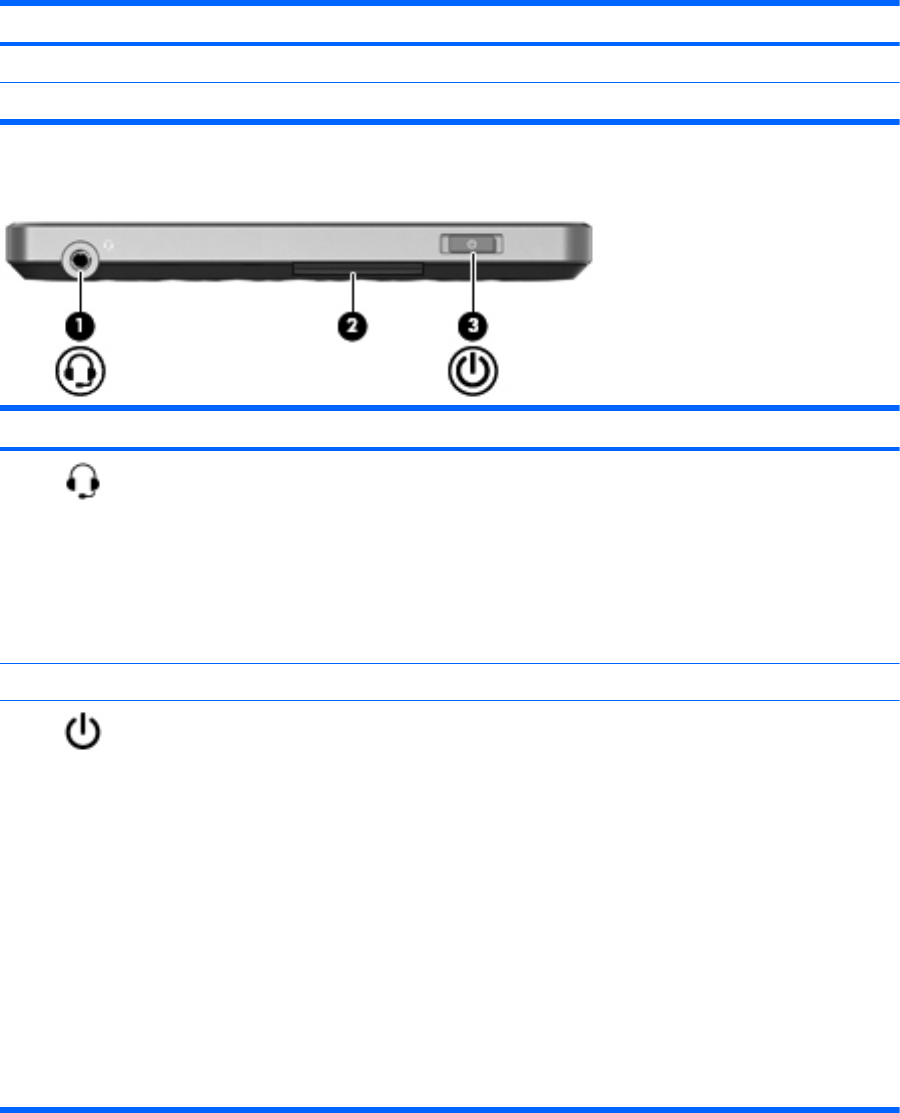
Component Description
(4) Volume down button Decreases speaker volume.
(5) Volume up button Increases speaker volume.
Right-side components
Component Description
(1) Audio-out (headphone) jack/Audio-in (microphone)
combo jack
Produces sound when connected to optional powered
stereo speakers, headphones, earbuds, a headset, or
television audio. Also connects an optional headset
microphone.
NOTE: When an audio component is connected to
the jack, the computer speakers are disabled.
The audio component cable must have a 4-conductor
connector.
2 Label door Holds the service tag.
(3) ●When the computer is off, slide the switch to turn
on the computer.
●When the computer is on, briefly slide the switch
to initiate Sleep.
●When the computer is in the Sleep state, briefly
slide the switch to exit Sleep.
●When the computer is in Hibernation, briefly slide
the switch to exit Hibernation.
If the computer has stopped responding and Windows
shutdown procedures are ineffective, slide and hold
the power switch for at least five seconds to turn off
the computer.
To learn more about your power settings, tap Start >
Control Panel > System and Security > Power
Options.
Identifying the hardware 11
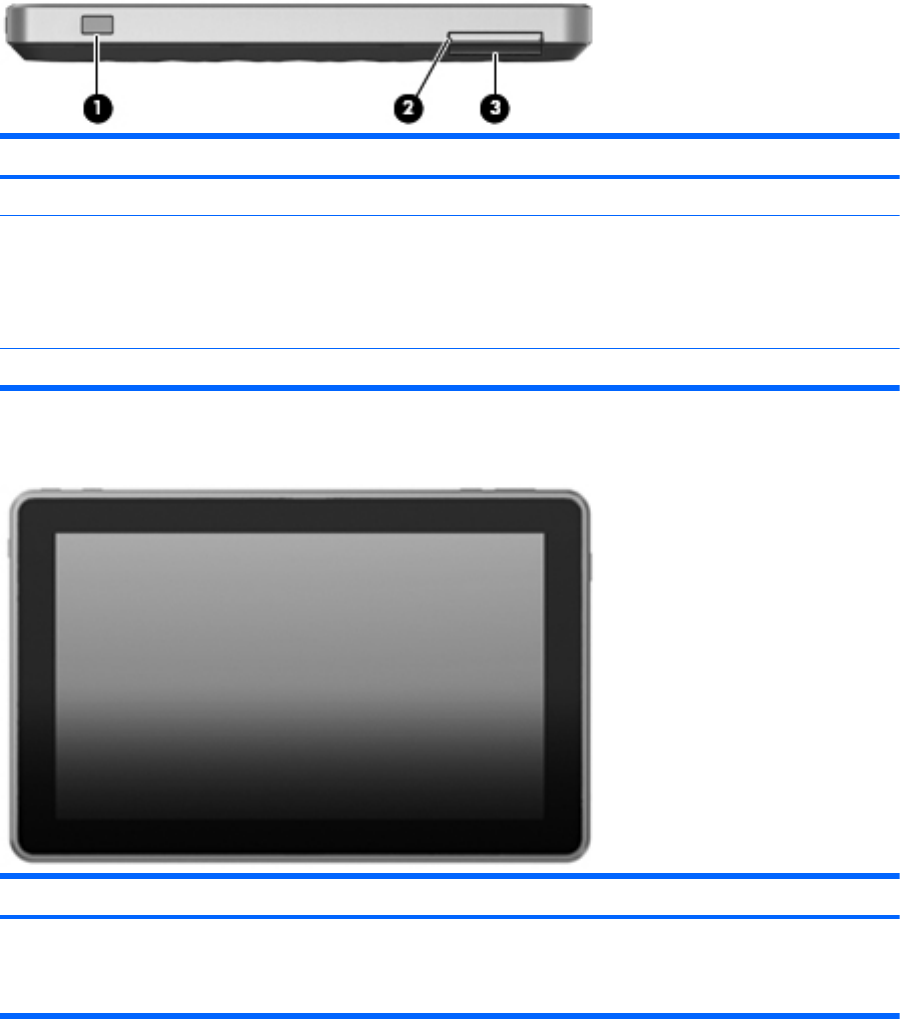
Left-side components
Component Description
(1) Windows security button ctrl+alt+del
(2) Digital Media slot Supports the following optional digital card formats:
●Secure Digital High Capacity (SDHC) Memory
Card (standard and large size)
●xD-Picture card
(3) SIM slot Contains a wireless subscriber identity module.
Display components
Component Description
(1) Inward-facing webcam Records video and captures still photographs.
NOTE: To take snapshots and record videos, you
can use the Slate Camera software.
12 Chapter 3 Knowing the parts
revised image will
be requested
before final review
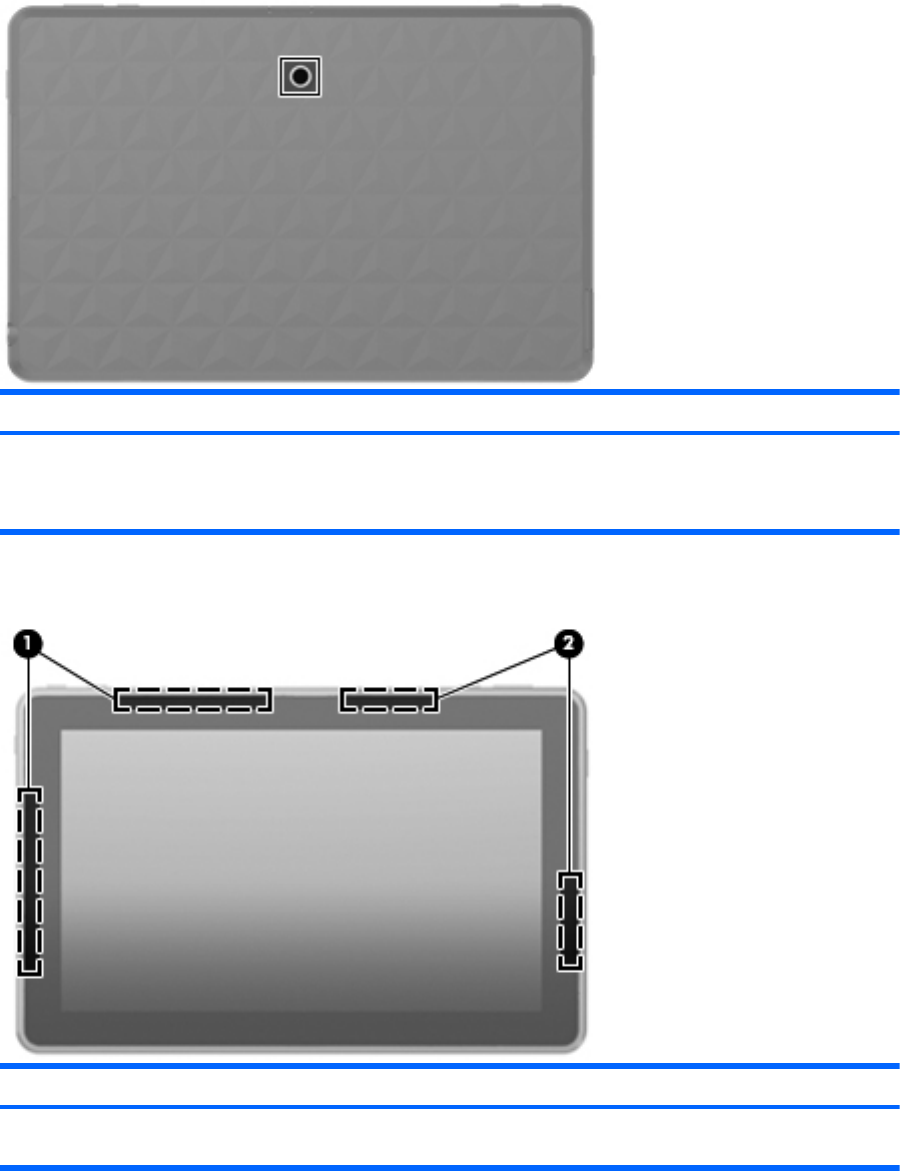
Bottom components
Component Description
(1) Outward-facing webcam Records video and captures still photographs.
NOTE: To capture and edit videos, you can use the
preinstalled Slate Camera software.
Wireless antennas
Component Description
(1) WWAN antennas (2) (select models only)* Send and receive wireless signals to communicate with
wireless wide-area networks (WWANs).
Identifying the hardware 13
revised image will
be requested
before final review
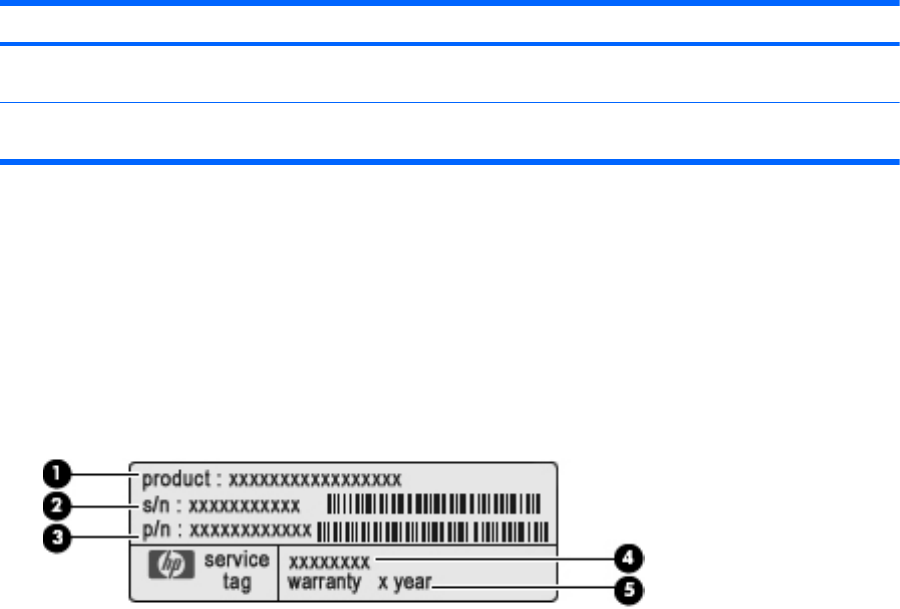
Component Description
(2) WLAN antennas (2)* Send and receive wireless signals to communicate with
wireless local-area networks (WLANs).
*The antennas are not visible from the outside of the computer. For optimal transmission, keep the areas
immediately around the antennas free from obstructions.
To see wireless regulatory notices, refer to the section of the Regulatory, Safety and Environmental
Notices that applies to your country or region. These notices are located in Help and Support.
Identifying the labels
The labels affixed to the computer provide information you may need when you troubleshoot system
problems or travel internationally with the computer.
●Service tag—Provides important information including the following:
◦Product name (1). This is the product name affixed to the front of your computer.
◦Serial number (s/n) (2). This is an alphanumeric identifier that is unique to each product.
◦Part Number/Product number (p/n) (3). This number provides specific information about the
hardware components of the product. The part number helps a service technician to
determine what components and parts are needed.
◦Model description (4). This is the alphanumeric identifier you use to locate documents,
drivers, and support for your computer.
◦Warranty period (5). This number describes the duration (in years) of the warranty period
for this computer.
Have this information available when you contact technical support. The service tag label is
located inside thelabel door of your computer.
●Microsoft® Certificate of Authenticity—Contains the Windows® Product Key. You may need the
Product Key to update or troubleshoot the operating system. This certificate is located inside the
label door of the computer.
●Regulatory label—Provides regulatory information about the computer, including the following:
◦Information about optional wireless devices and the approval markings of some of the
countries or regions in which the devices have been approved for use. An optional device
may be a wireless local area network (WLAN) device. You may need this information when
traveling internationally.
◦The serial number of your HP Mobile Broadband Module (select models only).
The regulatory label is located inside the label door of the computer.
14 Chapter 3 Knowing the parts
revised image will
be requested
before final review

4 Power management
Setting power options
Using power-saving states
The computer has two power-saving states enabled at the factory: Sleep and Hibernation.
When Sleep is initiated, the power light blinks and the screen clears. Your work is saved to memory,
letting you exit the Sleep state faster than exiting Hibernation. If the computer is in the Sleep state for
an extended period or if the battery reaches a critical battery level while in the Sleep state, the
computer initiates Hibernation.
When Hibernation is initiated, your work is saved to a hibernation file on the hard drive and the
computer turns off.
CAUTION: To prevent possible audio and video degradation, loss of audio or video playback
functionality, or loss of information, do not initiate Sleep or Hibernation while reading from or writing to
a disc or an external media card.
NOTE: You cannot initiate any type of networking connection or perform any computer functions
while the computer is in the Sleep state or in Hibernation.
Initiating and exiting Sleep
The system is set at the factory to initiate Sleep after 15 minutes of inactivity when running on battery
power and 30 minutes of inactivity when running on external power.
Power settings and timeouts can be changed using Power Options in Windows Control Panel.
With the computer on, you can initiate Sleep in any of the following ways:
●Briefly slide the power switch.
●Tap Start, tap the arrow next to the Shut down button, and then tap Sleep.
You can exit Sleep in any of the following ways:
●Briefly slide the power switch.
●Tap to activate the touch screen.
When the computer exits Sleep, the power light turns on and your work returns to the screen where
you stopped working.
NOTE: If you have set a password to be required when the computer exits Sleep, you must enter
your Windows password before your work returns to the screen.
Setting power options 15
Please review
chapter for
accuracy,
especially the
sections on Battery
power, since the
battery is not
removable.

Initiating and exiting Hibernation
Power settings and timeouts can be changed using Power Options in Windows Control Panel.
To initiate Hibernation:
▲Tap Start, tap the arrow next to the Shut down button, and then tap Hibernate.
To exit Hibernation:
▲Briefly slide the power switch.
When the computer exits Hibernation, the power light turns on and your work returns to the screen
where you stopped working.
NOTE: If you have set a password to be required when the computer exits Hibernation, you must
enter your Windows password before your work returns to the screen.
Using power plans
A power plan is a collection of system settings that manages how the computer uses power. Power
plans can help you conserve power and maximize computer performance.
The following power plans are available:
●HP recommended
●High performance
●Power saver
You can change the settings of these power plans through Power Options.
Viewing the current power plan
▲Tap the Battery Meter icon in the notification area, at the far right of the taskbar.
– or –
Select Start > Control Panel > System and Security > Power Options.
Selecting a different power plan
▲Tap the Battery Meter icon in the notification area, and then select a power plan from the list.
– or –
Select Start > Control Panel > System and Security > Power Options, and then select a
power plan from the list.
Customizing power plans
1. Tap the Battery Meter icon in the notification area and then tap Power options.
– or –
Select Start > Control Panel > System and Security > Power Options.
2. Select a power plan, and then tap Change plan settings.
16 Chapter 4 Power management

3. Change the settings as needed.
4. To change additional settings, tap Change advanced power settings and make your changes.
Setting password protection upon exiting Sleep or Hibernation
To set the computer to prompt for a password when the computer exits Sleep or Hibernation, follow
these steps:
1. Select Start > Control Panel > System and Security> Power Options.
2. In the left pane, tap Require a password on wakeup.
3. Tap Change Settings that are currently unavailable.
4. Tap Require a password (recommended).
5. Tap Save changes.
Using external AC power
External AC power is supplied through an approved AC adapter.
WARNING! To reduce potential safety issues, use only the AC adapter provided with the computer,
a replacement AC adapter provided by HP, or a compatible AC adapter purchased from HP.
Connect the computer to external AC power under any of the following conditions:
WARNING! Do not charge the battery while you are onboard aircraft.
●When you are charging or calibrating a battery
●When you are installing or modifying system software
●When you are writing information to a CD or DVD
When you connect the computer to external AC power, the following events occur:
●The battery begins to charge.
●If the computer is turned on, the Battery Meter icon in the notification area changes appearance.
When you disconnect external AC power, the following events occur:
●The computer switches to battery power.
●The display brightness is automatically decreased to save battery life. Press the f3 action key to
increase brightness or reconnect the AC adapter.
Using external AC power 17
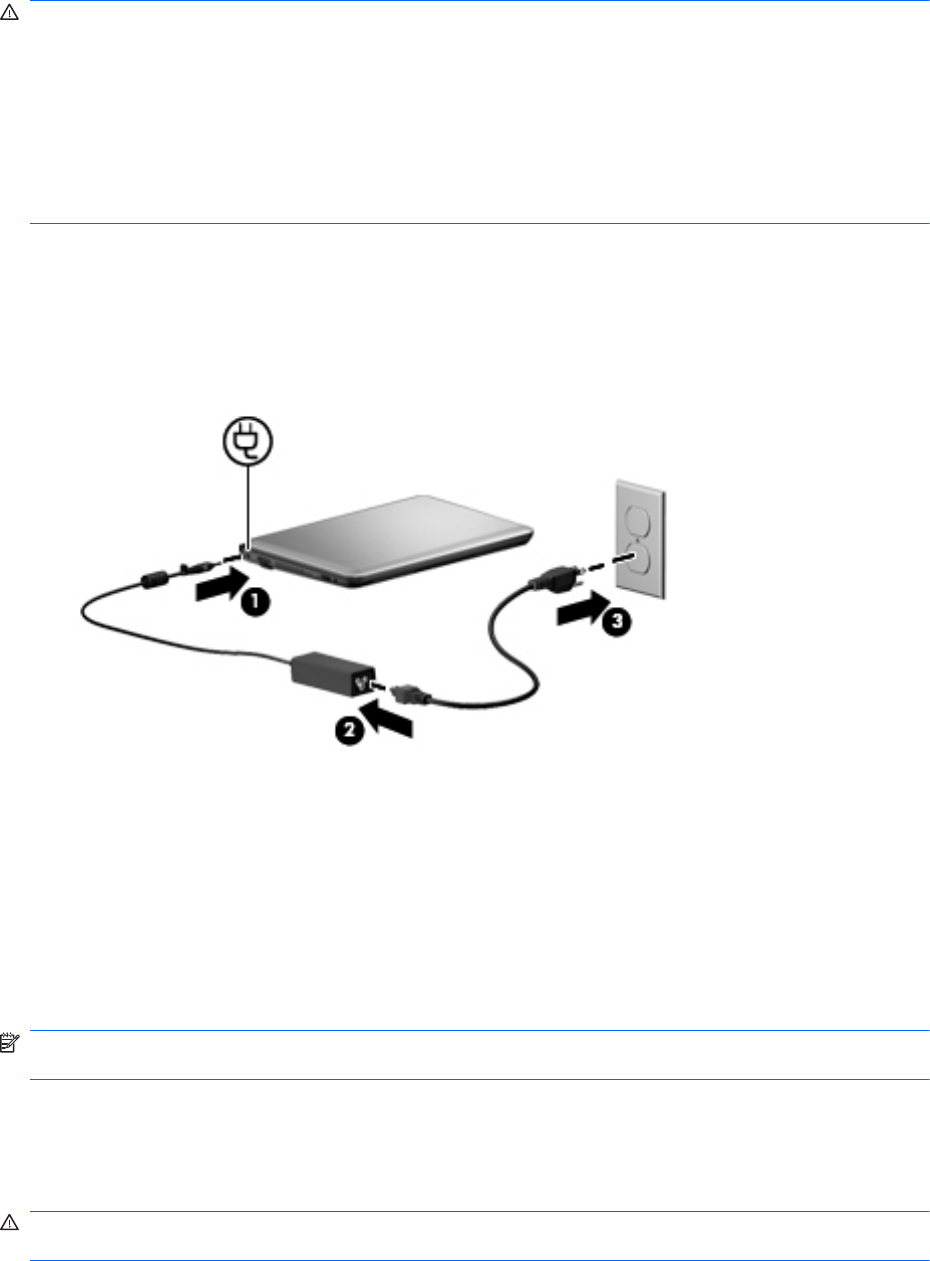
Connecting the AC adapter
WARNING! To reduce the risk of electric shock or damage to the equipment:
Plug the power cord into an AC outlet that is easily accessible at all times.
Disconnect power from the computer by unplugging the power cord from the AC outlet (not by
unplugging the power cord from the computer).
If provided with a 3-pin attachment plug on the power cord, plug the cord into a grounded (earthed) 3-
pin outlet. Do not disable the power cord grounding pin, for example, by attaching a 2-pin adapter.
The grounding pin is an important safety feature.
To connect the computer to external AC power, follow these steps:
1. Plug the AC adapter into the power connector (1) on the computer.
2. Plug the power cord into the AC adapter (2).
3. Plug the other end of the power cord into an AC outlet (3).
Using battery power
When a charged battery is in the computer and the computer is not plugged into external power, the
computer runs on battery power. When the computer is plugged into external AC power, the
computer runs on AC power.
If the computer contains a charged battery and is running on external AC power supplied through the
AC adapter, the computer switches to battery power if the AC adapter is disconnected from the
computer.
NOTE: The display brightness is decreased to save battery life when you disconnect AC power. To
increase brightness, use the f3 action key or reconnect the AC adapter.
You can keep a battery in the computer or in storage, depending on how you work. Keeping the
battery in the computer whenever the computer is plugged into AC power charges the battery and
also protects your work in case of a power outage. However, a battery in the computer slowly
discharges when the computer is off and unplugged from external power.
WARNING! To reduce potential safety issues, use only the battery provided with the computer, a
replacement battery provided by HP, or a compatible battery purchased from HP.
18 Chapter 4 Power management
new image will be
requested before
final review.

Battery life varies, depending on power management settings, programs running on the computer,
display brightness, external devices connected to the computer, and other factors.
Displaying the remaining battery charge
▲Move the pointer over the Battery Meter icon in the notification area, at the far right of the
taskbar.
Finding battery information in Help and Support
Help and Support provides the following tools and information about the battery:
●Battery Check tool to test battery performance
●Information on calibration, power management, and proper care and storage to maximize battery
life
●Information on battery types, specifications, life cycles, and capacity
To access battery information:
▲Select Start > Control Panel > Hardware and Sound > Power Options > Create a power
plan.
Using Battery Check
Help and Support provides information on the status of the battery installed in the computer.
To run Battery Check:
1. Connect the AC adapter to the computer.
NOTE: The computer must be connected to external power for Battery Check to function
properly.
2. Select Start > Help and Support > Troubleshoot > Power, Thermal and Mechanical.
3. Tap the Power tab, and then tap Battery Check.
Battery Check examines the battery and its cells to see if they are functioning properly, and then
reports the results of the examination.
Charging a battery
WARNING! Do not charge the computer battery while you are onboard aircraft.
The battery charges whenever the computer is plugged into external power through an AC adapter.
The battery charges whether the computer is off or in use, but it charges faster when the computer is
off.
Charging may take longer if a battery is new, has been unused for 2 weeks or more, or is much
warmer or cooler than room temperature.
Using battery power 19

To prolong battery life and optimize the accuracy of battery charge displays, follow these
recommendations:
●If you are charging a new battery, charge it fully before turning on the computer.
●Charge the battery until the battery light turns white.
NOTE: If the computer is on while the battery is charging, the Battery Meter icon in the
notification area may show 100 percent charge before the battery is fully charged.
●Allow the battery to discharge below 5 percent of a full charge through normal use before
charging it.
●If the battery has been unused for one month or more, calibrate the battery instead of simply
charging it.
The battery light displays charge status:
●Off: The computer is running on battery power.
●Blinking white: The battery has reached a low battery level, a critical battery level, or there is a
battery error. When the battery reaches a critical battery level, the battery light begins blinking
rapidly.
●Amber: A battery is charging.
●White: The computer is connected to external power and the battery is fully charged,
Maximizing battery discharge time
Battery discharge time varies depending on the features you use while on battery power. Maximum
discharge time gradually shortens, as the battery storage capacity naturally degrades.
Tips for maximizing battery discharge time:
●Decrease the brightness on the display.
●Remove the battery from the computer when it is not being used or charged.
●Store the battery in a cool, dry location.
Managing low battery levels
The information in this section describes the alerts and system responses set at the factory. Some
low-battery alerts and system responses can be changed using Power Options in Windows Control
Panel. Preferences set using Power Options do not affect lights.
Identifying low battery levels
When a battery that is the sole power source for the computer reaches a low battery level, the battery
light blinks.
If a low battery level is not resolved, the computer enters a critical battery level, and the battery light
blinks rapidly.
20 Chapter 4 Power management

The computer takes the following actions for a critical battery level:
●If Hibernation is enabled and the computer is on or in Sleep, the computer initiates Hibernation.
●If Hibernation is disabled and the computer is on or in Sleep, the computer remains briefly in
Sleep, and then shuts down and loses any unsaved information.
Resolving a low battery level
CAUTION: To reduce the risk of losing information when the computer reaches a critical battery
level and has initiated Hibernation, do not restore power until the power light turns off.
Resolving a low battery level when external power is available
▲Connect to an approved AC adapter.
Resolving a low battery level when a charged battery is available
1. Turn off the computer or initiate Hibernation.
2. Remove the discharged battery, and then insert a charged battery.
3. Turn on the computer.
Resolving a low battery level when no power source is available
▲Initiate Hibernation.
– or –
Save your work and shut down the computer.
Resolving a low battery level when the computer cannot exit Hibernation
When the computer lacks sufficient power to exit Hibernation, follow these steps:
1. Insert a charged battery or plug the computer into external power.
2. Exit Hibernation by briefly sliding the power switch.
Calibrating a battery
Calibrate a battery under the following conditions:
●When battery charge displays seem inaccurate
●When you observe a significant change in battery run time
Even if a battery is heavily used, it should not need to be calibrated more than once a month. It is also
not necessary to calibrate a new battery.
Step 1: Fully charge the battery
WARNING! Do not charge the computer battery while you are onboard aircraft.
NOTE: The battery charges whether the computer is off or in use, but it charges faster when the
computer is off.
Using battery power 21
To fully charge the battery:
1. Insert the battery into the computer.
2. Connect the computer to an AC adapter and then plug the adapter into external power.
The battery light on the computer turns amber.
3. Leave the computer plugged into external power until the battery is fully charged.
The battery light on the computer turns white.
Step 2: Disable Hibernation and Sleep
1. Tap the Battery Meter icon in the notification area, and then tap Power options.
– or –
Select Start > Control Panel > System and Security > Power Options.
2. Under the current power plan, tap Change plan settings.
3. Record the Turn off the display settings listed in the On battery column so that you can reset
them after the calibration.
4. Change the Turn off the display settings to Never.
5. Tap Change advanced power settings.
6. Tap the plus sign next to Sleep, and then tap the plus sign next to Hibernate after.
7. Record the On battery setting under Hibernate after so that you can reset it after the
calibration.
8. Change the On battery setting to Never.
9. Tap OK.
10. Tap Save changes.
Step 3: Discharge the battery
The computer must remain on while the battery is being discharged. The battery can discharge
whether or not you are using the computer, but the battery discharges faster while you are using it.
●If you plan to leave the computer unattended during the discharge, save your information before
beginning the discharge procedure.
●If you use the computer occasionally during the discharge procedure and have set energy-
saving timeouts, expect the following performance from the system during the discharge
process:
◦The monitor does not turn off automatically.
◦Hard drive speed does not decrease automatically when the computer is idle.
◦System-initiated Hibernation does not occur.
22 Chapter 4 Power management

To discharge a battery:
1. Unplug the computer from its external power source, but do not turn off the computer.
2. Run the computer on battery power until the battery is discharged. The battery light begins to
blink amber when the battery has discharged to a low battery level. When the battery is
discharged, the battery light turns off and the computer shuts down.
Step 4: Fully recharge the battery
To recharge the battery:
1. Plug the computer into external power and maintain external power until the battery is fully
recharged. When the battery is recharged, the battery light on the computer turns white.
You can use the computer while the battery is recharging, but the battery charges faster if the
computer is off.
2. If the computer is off, turn it on when the battery is fully charged and the battery light has turned
white.
Step 5: Reenable Hibernation and Sleep
CAUTION: Failure to reenable Hibernation after calibration may result in a full battery discharge and
information loss if the computer reaches a critical battery level.
1. Tap the Battery Meter icon in the notification area, and then tap Power options.
– or –
Select Start > Control Panel > System and Security > Power Options.
2. Under the current power plan, tap Change plan settings.
3. Reenter the settings that you recorded for the items in the On battery column.
4. Tap Change advanced power settings.
5. Tap the plus sign next to Sleep, and then tap the plus sign next to Hibernate after.
6. Reenter the setting that you recorded for On battery.
7. Tap OK.
8. Tap Save changes.
Conserving battery power
●Select the Power saver power plan through Power Options under System and Security in
Windows Control Panel.
●Turn off wireless and local area network (LAN) connections and exit modem applications when
you are not using them.
●Disconnect external devices that are not plugged into an external power source, when you are
not using them.
●Stop, disable, or remove any external media cards that you are not using.
Using battery power 23

●Use the f2 and f3 action keys to adjust screen brightness as needed.
●If you leave your work, initiate Sleep or Hibernation, or shut down the computer.
Shutting down the computer
CAUTION: Unsaved information will be lost when the computer is shut down.
The Shut down command closes all open programs, including the operating system, and then turns
off the display and computer.
Shut down the computer under any of the following conditions:
●When you need to replace the battery or access components inside the computer
●When you are connecting an external hardware device that does not connect to a USB port
●When the computer is unused and disconnected from external power for an extended period
Although you can shut down the computer with the power switch, the recommended procedure is to
use the Windows Shut down command.
To shut down the computer, follow these steps:
NOTE: If the computer is in the Sleep state or in Hibernation, you must first exit Sleep or
Hibernation before shut down is possible.
1. Save your work and close all open programs.
2. Tap Start.
3. Tap Shut down.
If the computer is unresponsive and you are unable to use the preceding shut down procedures, try
the following emergency procedures in the sequence provided:
●Press the Windows Security button on the left side of the Slate, and then slide the power switch.
●Slide and hold the power switch for at least 5 seconds.
●Disconnect the computer from external power and remove the battery.
24 Chapter 4 Power management

5 Internet
Your computer supports wireless Internet access. For mobile Internet access, you can use a wireless
connection. To learn about setting up a wireless network or adding your computer to an existing
network, refer to the “Connecting to a wireless network” section
25
Please review
chapter for
accuracy.
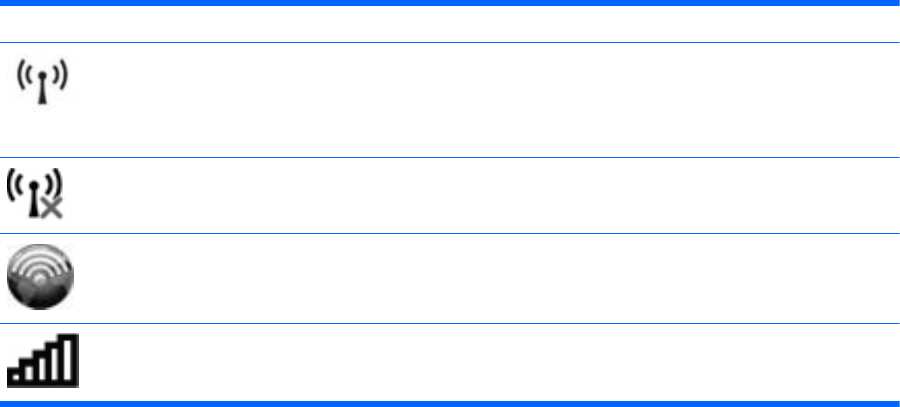
Connecting to a wireless network
Using wireless devices
Wireless technology transfers data across radio waves instead of wires. Your computer may be
equipped with one or more of the following wireless devices:
●Wireless local area network (WLAN) device—Connects the computer to wireless local area
networks (commonly referred to as Wi-Fi networks, wireless LANs, or WLANs) in corporate
offices, your home, and public places such as airports, restaurants, coffee shops, hotels, and
universities. In a WLAN, each mobile wireless device communicates with a wireless router or a
wireless access point.
●HP Mobile Broadband Module (select models only)—A wireless wide area network (WWAN)
device that provides access to information wherever mobile network operator service is
available. In a WWAN, each mobile device communicates to a mobile network operator’s base
station. Mobile network operators install networks of base stations (similar to cell phone towers)
throughout large geographic areas, effectively providing coverage across entire states, regions,
or even countries.
●Bluetooth® device—Creates a personal area network (PAN) to connect to other Bluetooth-
enabled devices such as computers, phones, printers, headsets, speakers, and cameras. In a
PAN, each device communicates directly with other devices, and devices must be relatively
close together— typically within 10 meters (approximately 33 feet) of each other.
The computer supports the following IEEE industry standards:
●802.11b, the first popular standard, supports data rates of up to 11 Mbps and operates at a
frequency of 2.4 GHz.
●802.11g supports data rates of up to 54 Mbps and operates at a frequency of 2.4 GHz. An
802.11g WLAN device is backward compatible with 802.11b devices, so they can operate on the
same network.
For more information on wireless technology, refer to the information and Web site links provided in
Help and Support.
Identifying wireless and network icons
Icon Name Description
Wireless (connected) Identifies the location of the wireless lights and the wireless buttons
on the computer. Also identifies the Wireless Assistant software on
the computer and indicates that one or more of the wireless devices
are on.
Wireless
(disconnected)
Identifies the Wireless Assistant software on the computer and
indicates that all of the wireless devices are off.
HP Connection
Manager
Opens HP Connection Manager, which enables you to create a
connection with an HP Mobile Broadband device (select models
only).
Network (connected) Indicates that one or more of your network drivers are installed, one
or more network devices are connected to a wireless network, and
one or more network devices may be connected to a wired network.
26 Chapter 5 Internet

Network (disabled/
disconnected)
Indicates that one or more of your network drivers are installed, no
wireless connections are available or all wireless network devices are
disabled by the wireless button or Wireless Assistant, and no network
devices are connected to a wired network.
Network
(disconnected)
Indicates that one or more of your network drivers are installed and
wireless connections are available, but no network devices are
connected to a wired or wireless network.
Using the wireless controls
You can control the wireless devices in your computer using these features:
●The f12 wireless action key
●HP Connection Manager software (select models only)
●Wireless Assistant software (select models only)
●Operating system controls
Using the wireless action key
The computer has a wireless action key (f12), one or more wireless devices, and one wireless light.
All of the wireless devices on your computer are enabled at the factory.
The wireless light indicates the overall power state of your wireless devices, not the status of
individual devices. If the wireless light is white, at least one wireless device is on. If the wireless light
is off, all wireless devices are off.
Because the wireless devices are enabled at the factory, you can use the wireless action key (f12) to
turn on or turn off all of the wireless devices simultaneously.
Using HP Connection Manager (select models only)
You can use HP Connection Manager to connect to WWANs using the HP Mobile Broadband device
in your computer (select models only).
▲To start Connection Manager, tap the Connection Manager icon in the notification area, at the
far right of the taskbar.
– or –
Select Start > All Programs > HP Connection Manager > HP Connection Manager.
For more details about using Connection Manager, refer to the Connection Manager software Help.
Using Wireless Assistant software
A wireless device can be turned on or off using the Wireless Assistant software. If a wireless device is
disabled by Setup Utility, it must be reenabled by Setup Utility before it can be turned on or off using
Wireless Assistant.
NOTE: Enabling or turning on a wireless device does not automatically connect the computer to a
network or a Bluetooth-enabled device.
Connecting to a wireless network 27
To view the state of the wireless devices, tap the Show hidden icons icon, the arrow at the left of the
notification area, and position the mouse pointer over the wireless icon.
If the wireless icon is not displayed in the notification area, complete the following steps to change
Wireless Assistant properties:
1. Select Start > Control Panel > Network and Internet > HP Wireless Assistant.
2. Tap Properties.
3. Select the check box next to HP Wireless Assistant icon in notification area.
4. Tap Apply.
5. Tap Close.
For more information, refer to the Wireless Assistant software Help:
1. Open Wireless Assistant by double-taping the icon in the notification area.
2. Tap the Help button.
You can use the properties dialog box in Wireless Assistant to show the on/off controls for each
installed wireless device and control the devices separately. To show the on/off controls:
1. Double-tap the Wireless Assistant icon in the notification area, at the far right of the taskbar.
2. Tap Properties.
3. Select the Independent controls for installed wireless devices check box, and then tap
Apply.
4. Tap Turn off or Turn on to control each wireless device separately.
Using operating system controls
Some operating systems also offer a way to manage integrated wireless devices and the wireless
connection. For example, Windows provides the Network and Sharing Center that allows you to set
up a connection or network, connect to a network, manage wireless networks, and diagnose and
repair network problems.
▲To access the Network and Sharing Center, tap Start > Control Panel > Network and Sharing
Center.
For more information, tap Start > Help and Support.
Using a WLAN
With a WLAN device, you can access a wireless local area network (WLAN), which is composed of
other devices and accessories that are linked by a wireless router or a wireless access point.
28 Chapter 5 Internet
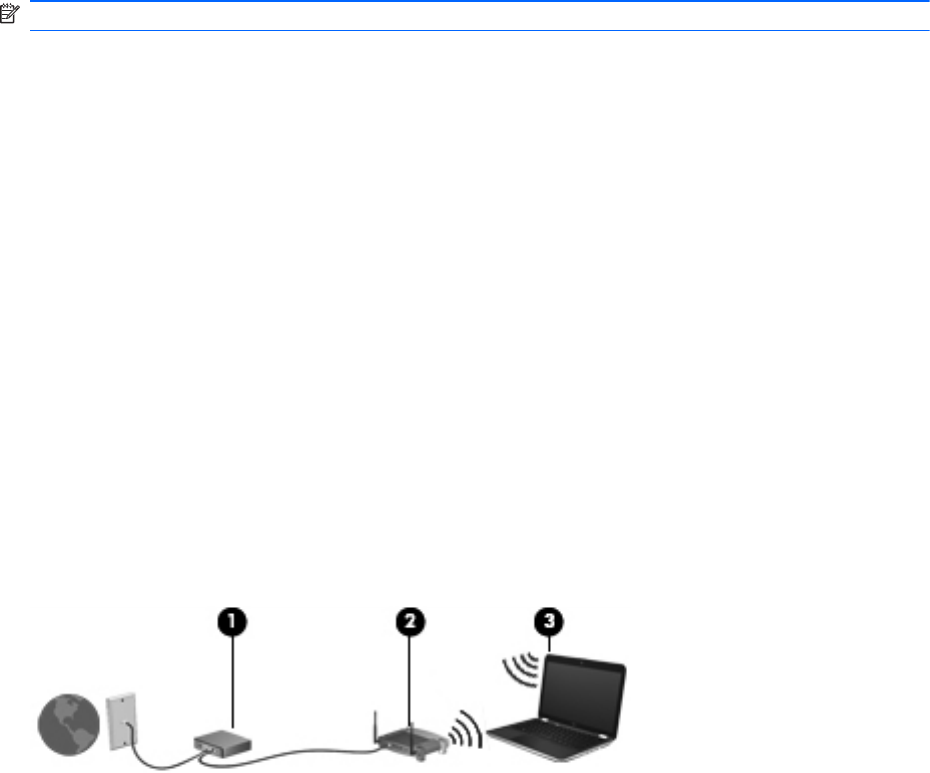
NOTE: The terms wireless router and wireless access point are often used interchangeably.
●A large-scale WLAN, such as a corporate or public WLAN, typically uses wireless access points
that can accommodate a large number of devices and accessories and can separate critical
network functions.
●A home or small office WLAN typically uses a wireless router, which allows several wireless and
wired devices to share an Internet connection, a printer, and files without requiring additional
pieces of hardware or software.
To use the WLAN device in your computer, you must connect to a WLAN infrastructure (provided
through a service provider or a public or corporate network).
Setting up a WLAN
To set up a WLAN and connect to the Internet, you need the following equipment:
●A broadband modem (either DSL or cable) (1) and high-speed Internet service purchased from
an Internet service provider (ISP)
●A wireless router (purchased separately) (2)
●Computer equipped with a wireless device (3)
The illustration below shows an example of a wireless network installation that is connected to the
Internet.
As your network grows, additional wireless and wired devices can be connected to the network to
access the Internet.
For help in setting up your WLAN, refer to the information provided by your router manufacturer or
your ISP.
Protecting your WLAN
It is essential to understand that because the WLAN standard was designed with only limited security
capabilities—basically to foil casual eavesdropping rather than more powerful forms of attack—
WLANs are vulnerable to well-known and well-documented security weaknesses.
WLANs in public areas, or “hotspots,” like coffee shops and airports may not provide any security.
New technologies are being developed by wireless manufacturers and hotspot service providers that
make the public environment more secure and anonymous. If you are concerned about the security of
your computer in a hotspot, limit your network activities to noncritical e-mail and basic Internet surfing.
When you set up a WLAN or access an existing WLAN, always enable security features to protect
your network from unauthorized access. The common security levels are Wi-Fi Protected Access
(WPA)-Personal and Wired Equivalent Privacy (WEP). Because wireless radio signals travel outside
the network, other WLAN devices can pick up unprotected signals and either connect to your network
Connecting to a wireless network 29

(uninvited) or capture information being sent across it. However, you can take precautions to protect
your WLAN:
●Use a wireless transmitter with built-in security
Many wireless base stations, gateways, or routers provide built-in security features such as
wireless security protocols and firewalls. With the correct wireless transmitter, you can protect
your network from the most common wireless security risks.
●Work behind a firewall
A firewall is a barrier that checks both data and requests for data that are sent to your network,
and discards any suspicious items. Firewalls are available in many varieties, both software and
hardware. Some networks use a combination of both types.
●Use wireless encryption
A variety of sophisticated encryption protocols is available for your WLAN. Find the solution that
works best for your network security:
◦Wired Equivalent Privacy (WEP) is a wireless security protocol that encodes or encrypts
all network data before it is transmitted using a WEP key. Usually, you can allow the
network to assign the WEP key. Alternatively, you can set up your own key, generate a
different key, or choose other advanced options. Without the correct key, others will not be
able to use the WLAN.
◦WPA (Wi-Fi Protected Access), like WEP, uses security settings to encrypt and decrypt
data that is transmitted over the network. However, instead of using one static security key
for encryptions as WEP does, WPA uses “temporal key integrity protocol” (TKIP) to
dynamically generate a new key for every packet. It also generates different sets of keys for
each device on the network.
Connecting to a WLAN
To connect to the WLAN, follow these steps:
1. Be sure that the WLAN device is on. If it is on, the wireless is white. If the wireless light is off,
press the f12 action key to turn on the wireless connection.
2. Tap the network icon in the notification area, at the far right of the taskbar.
3. Select your WLAN from the list.
4. Tap Connect.
If the network is a security-enabled WLAN, you are prompted to enter a network security key,
which is a security code. Type the code, and then tap OK to complete the connection.
NOTE: If no WLANs are listed, you are out of range of a wireless router or access point.
NOTE: If you do not see the network you want to connect to, tap Open Network and Sharing
Center, and then tap Set up a new connection or network. A list of options is displayed. You
can choose to manually search for and connect to a network or to set up a new network
connection.
After the connection is made, place the mouse pointer over the network icon in the notification area,
at the far right of the taskbar, to verify the name and status of the connection.
30 Chapter 5 Internet

NOTE: The functional range (how far your wireless signals travel) depends on WLAN
implementation, router manufacturer, and interference from other electronic devices or structural
barriers such as walls and floors.
More information about using a WLAN is available through the following resources:
●Information from your ISP and the manufacturer's instructions included with your wireless router
and other WLAN equipment
●Information and Web site links provided in Help and Support
For a list of public WLANs near you, contact your ISP or search the Web. Web sites that list public
WLANs include Cisco Internet Mobile Office Wireless Locations, Hotspotlist, and Geektools. Check
with each public WLAN location for cost and connection requirements.
For additional information on connecting your computer to a corporate WLAN, contact your network
administrator or IT department.
Roaming to another network
When you move your computer within range of another WLAN, Windows attempts to connect to that
network. If the attempt is successful, your computer is automatically connected to the new network. If
Windows does not recognize the new network, follow the same procedure you used initially to
connect to your WLAN.
Connecting to a wireless network 31

Using HP Mobile Broadband (select models only)
HP Mobile Broadband enables your computer to use wireless wide area networks (WWANs) to
access the Internet from more places and over larger areas than it can by using WLANs. Using HP
Mobile Broadband requires a network service provider (called a mobile network operator), which in
most cases is a mobile phone network operator. Coverage for HP Mobile Broadband is similar to
mobile phone voice coverage.
When used with mobile network operator service, HP Mobile Broadband gives you the freedom to
stay connected to the Internet, send e-mail, or connect to your corporate network whether you are on
the road or outside the range of Wi-Fi hotspots.
The activation requirements for Code Division Multiple Access (CDMA) and Global System for Mobile
Communications (GSM) are different as CDMA requires an MEID and GSM requires a SIM plus the
SIM information.
HP Mobile Broadband supports the following technologies:
●HSPA (High Speed Packet Access), which provides access to networks based on the GSM
telecommunications standard.
For HSPA service activation, you may need the HP Mobile Broadband Module International
Mobile Equipment Identity (IMEI) number to activate mobile broadband service. The IMEI
number is printed on a label inside the label door of your computer.
HSPA mobile network operators require the use of a subscriber identity module (SIM). A SIM
contains basic information about you, such as a personal identification number (PIN), as well as
network information.
Some computers include a SIM that is preinstalled in the SIM card slot. If the SIM is not
preinstalled, it may be provided in the packet of HP Mobile Broadband information provided with
your computer, or the mobile network operator may provide it separately from the computer.
For information on inserting and removing the SIM, refer to the “Inserting a SIM” and “Removing
a SIM” sections in this chapter.
●EV-DO (Evolution Data Optimized), which provides access to networks based on the CDMA
telecommunications standard.
You may need the HP Mobile Broadband Module Mobile Equipment Identifier (MEID) to activate
mobile broadband service. The MEID is printed on a label inside the label door of your computer.
For information on HP Mobile Broadband and how to activate service with a preferred mobile network
operator, refer to the HP Mobile Broadband information included with your computer. For additional
information, see the HP Web site at http://www.hp.com/go/mobilebroadband (U.S. only).
Inserting a SIM
CAUTION: When inserting a SIM, position the card with the slanted corner as shown in the
illustration. If a SIM is inserted backwards or upside down, the battery may not snap into place
properly and could damage the SIM and the SIM connector.
To prevent damage to the connectors, use minimal force when inserting a SIM.
32 Chapter 5 Internet
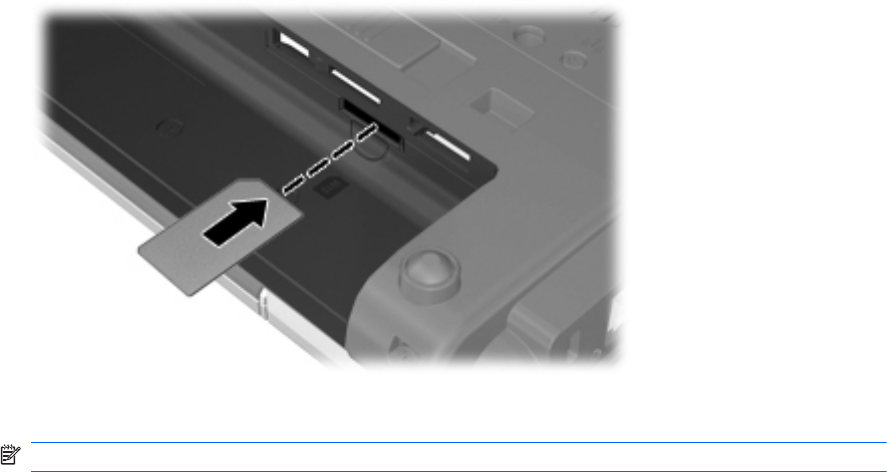
To insert a SIM:
1. Shut down the computer. If you are not sure whether the computer is off or in Hibernation, turn
the computer on by sliding the power switch. Then shut down the computer through the
operating system.
2. Disconnect all external devices connected to the computer.
3. Unplug the power cord from the AC outlet.
4. Turn the computer upside down on a flat surface, with the battery bay toward you.
5. Remove the battery.
6. Insert the SIM into the SIM slot, and gently push the SIM into the slot until it is firmly seated.
7. Replace the battery.
NOTE: If the battery is not replaced, HP Mobile Broadband is disabled.
8. Reconnect external power.
9. Reconnect external devices.
10. Turn on the computer.
Removing a SIM
To remove a SIM:
1. Shut down the computer. If you are not sure whether the computer is off or in Hibernation, turn
the computer on by sliding the power switch. Then shut down the computer through the
operating system.
2. Disconnect all external devices connected to the computer.
3. Unplug the power cord from the AC outlet.
4. Turn the computer upside down on a flat surface, with the battery bay toward you.
5. Remove the battery.
Using HP Mobile Broadband (select models only) 33
new image will be
requested before
final review
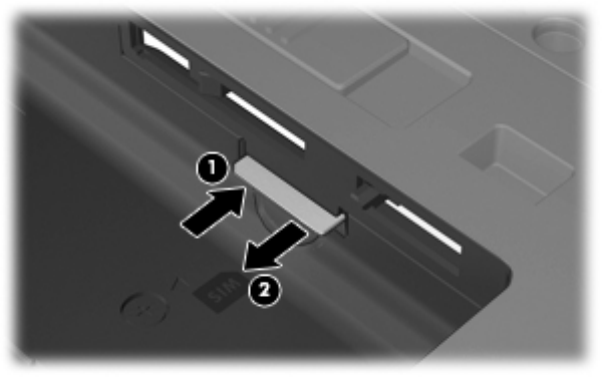
6. Press in on the SIM, and then remove it from the slot.
7. Replace the battery and the back cover.
8. Reconnect external power.
9. Reconnect external devices.
10. Turn on the computer.
34 Chapter 5 Internet
new image will be
requested before
final review
Using Bluetooth wireless devices
A Bluetooth device provides short-range wireless communications that replace the physical cable
connections that traditionally link electronic devices such as the following:
●Computers (desktop, notebook, PDA
●Phones (cellular, smart phone)
●Imaging devices (printer, camera)
●Audio devices (headset, speakers)
Bluetooth devices provide peer-to-peer capability that allows you to set up a personal area network
(PAN) of Bluetooth devices. For information on configuring and using Bluetooth devices, refer to the
Bluetooth software Help.
Bluetooth and Internet Connection Sharing (ICS)
HP does not recommend setting up one computer with Bluetooth as a host and using it as a gateway
through which other computers may connect to the Internet. When two or more computers are
connected using Bluetooth, and Internet Connection Sharing (ICS) is enabled on one of the
computers, the other computers may not be able to connect to the Internet using the Bluetooth
network.
The strength of Bluetooth is in synchronizing information transfers between your Mini and wireless
devices including cellular phones, printers, cameras, and PDAs. The inability to consistently connect
two or more computers to share the Internet through Bluetooth is a limitation of Bluetooth and the
Windows operating system.
Using Bluetooth wireless devices 35
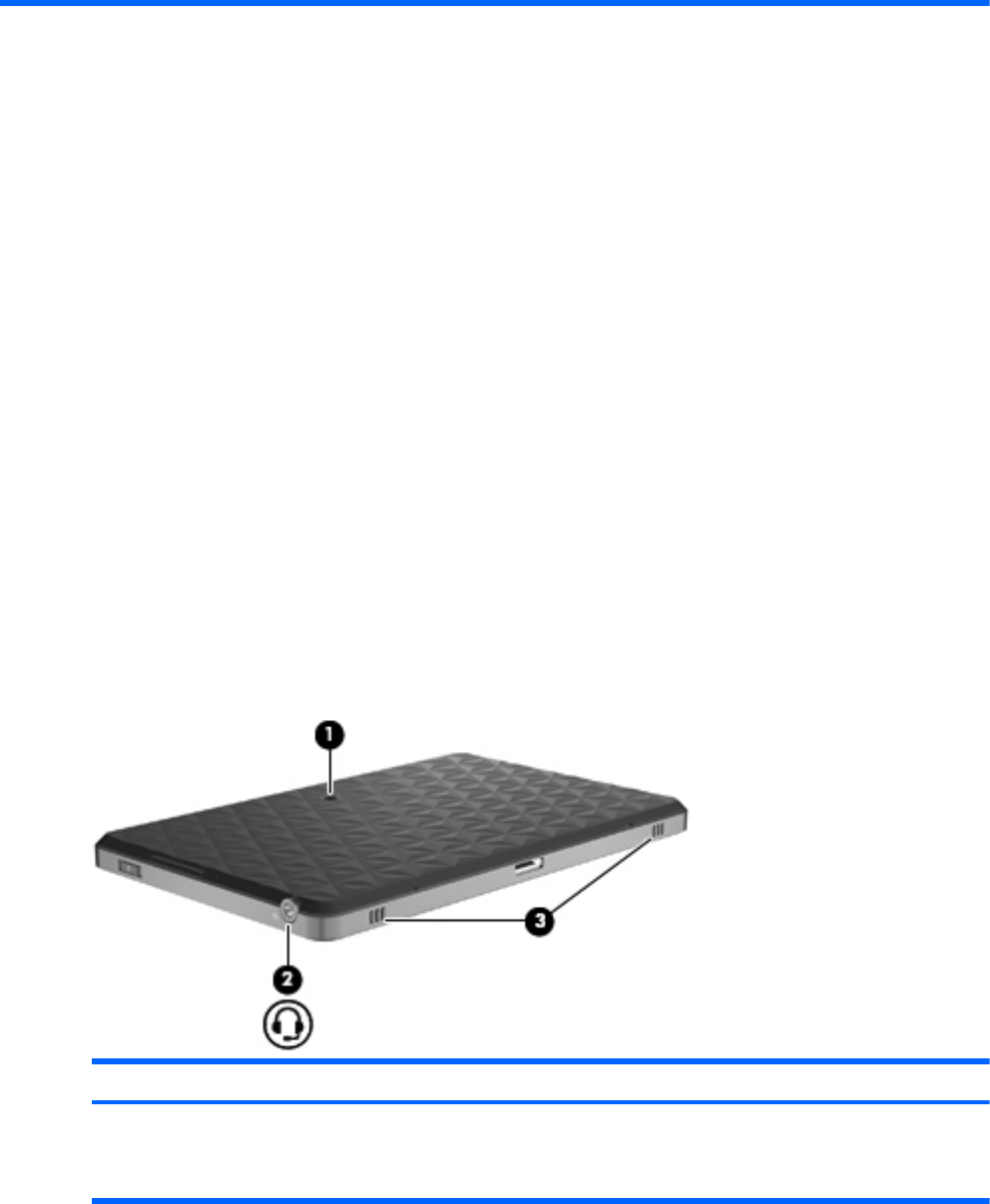
6 Multimedia
Multimedia features
Your computer includes multimedia features that allow you to listen to music, watch movies, and view
pictures. Your computer may include the following multimedia components:
●Integrated speakers for listening to music
●Integrated webcam that allows you to capture photographs and videos
●Preinstalled multimedia software that allows you to play and manage your music, movies, and
pictures
The following sections explain how to identify and use the multimedia components included with your
computer.
Identifying your multimedia components
The following illustration and table describe the multimedia features of the computer.
Component Description
(1) Outward-facing webcam Records video and captures still photographs.
NOTE: To capture and edit videos, you can use the
preinstalled Arcsoft WebCam Companion 3 software
36 Chapter 6 Multimedia
Please review
chapter for
accuracy.

Component Description
(2) Audio-out (headphone) jack/Audio-in
(microphone) combo jack
Produces sound when connected to optional powered
stereo speakers, headphones, earbuds, a headset, or
television audio. Also connects an optional headset
microphone.
NOTE: When an audio component is connected to the
jack, the computer speakers are disabled.
The audio component cable must have a 4-conductor
connector.
(3) Speakers (2) Produce sound.
Adjusting the volume
You can adjust the volume using the following computer volume action keys:
●To decrease volume, press the volume down button on the side of the Slate.
●To increase volume, press the volume up button on the side of the Slate.
●Windows® volume control:
a. Tap the Speakers icon in the notification area, at the far right of the taskbar.
b. Increase or decrease the volume by moving the slider up or down. Tap the Mute Speakers
icon to mute the volume.
– or –
a. Tap the Speakers icon in the notification area, and then tap Open Volume Mixer.
b. In the Speakers column, increase or decrease the volume by moving the slider up or down.
You can also mute the volume by taping the Mute Speakers icon.
If the Speakers icon is not displayed in the notification area, follow these steps to add it:
a. Right-tap the Show hidden icons icon (the arrow at far left of the notification area).
b. Tap Customize notification icons.
c. Under Behaviors, tap Show icon and notifications for the Speakers icon.
d. Tap OK.
●Program volume control:
Volume can also be adjusted within some programs.
Multimedia software
Your computer includes preinstalled multimedia software. Depending on the hardware and software
included with the computer, the following multimedia tasks may be supported:
●Playing digital media, including audio and video CDs, audio and video DVDs, and Internet radio
●Creating or copying data CDs
Multimedia software 37

●Creating, editing, and burning audio CDs
●Creating, editing, and burning a video or movie to a DVD or video CD
Using preinstalled multimedia software
To locate preinstalled multimedia software:
▲Tap Start > All Programs, and then open the multimedia program you want to use. For
example, if you want to use Slate Home, tap Home, and then tap Music or Video.
NOTE: Some programs may be located in subfolders.
Installing multimedia software from the Internet
▲To install multimedia software from the Internet, go to the software manufacturer’s Web site and
follow the instructions.
NOTE: Software downloaded from the Internet may contain viruses. Refer to the “Security” chapter
for more information.
38 Chapter 6 Multimedia

Audio
Your computer has a variety of audio features that allow you to:
●Play music using your computer speakers and/or connected external speakers.
●Record sound using the internal microphone or an optional external headset microphone.
●Download music from the Internet.
●Create multimedia presentations using audio and images.
●Transmit sound and images with instant messaging programs.
Connecting external audio devices
WARNING! To reduce the risk of personal injury, adjust the volume before putting on headphones,
earbuds, or a headset. For additional safety information, refer to the Regulatory, Safety and
Environmental Notices.
To connect external devices such as external speakers, headphones, or a headset microphone, refer
to the information provided with the device. For best results, remember the following tips:
●Be sure that the device cable has a 4-conductor connector that supports both audio-out
(headphone) and audio-in (microphone).
●Be sure that the external device cable is securely connected to the jack on your computer.
●Be sure to install any drivers required by the external device.
NOTE: A driver is a required program that acts like a translator between the device and the
programs that use the device.
Checking your audio functions
To check the system sound on your computer, follow these steps:
1. Tap Start > Control Panel.
2. Tap Hardware and Sound.
3. Tap Sound.
4. When the Sound window opens, tap the Sounds tab. Under Program Events, tap any sound
event, such as a beep or alarm, and tap the Test button.
You should hear sound through the speakers or through connected headphones.
To check the record functions of the computer, follow these steps:
1. Tap Start > All Programs > Accessories > Sound Recorder.
2. Tap Start Recording and speak into the microphone. Save the file to your desktop.
3. Open Slate Music and play back the sound.
NOTE: For best results when recording, speak directly into the microphone and record sound in a
setting free of background noise.
Audio 39
To confirm or change the audio settings on your computer, tap Start > Control Panel > Hardware
and Sound > Sound.
40 Chapter 6 Multimedia
Video
Your computer enables you to use a variety of video features:
●Watch movies
●Play games over the Internet
●Edit pictures and video to create presentations
Video 41

Webcam
Your computer includes an outward-facing integrated webcam and an inward-facing integrated
webcam. The webcam is an input device that allows you to record video and capture still
photographs.
NOTE: To record and edit videos, you can use the preinstalled Slate Camera software.
To access the webcam using Slate Camera:
1. Tap Start > All Programs > Slate Home.
2. Tap Camera in the Quick Launch area.
NOTE: For more information, refer to Slate Camera software Help.
42 Chapter 6 Multimedia

7Security
Protecting the computer
Standard security features provided by the Windows operating system and the non-Windows Setup
Utility can protect your personal settings and data from a variety of risks.
Follow the procedures in this chapter to use the following features:
●Passwords
●Firewall software
●Antivirus support (Norton Internet Security)
●Critical security updates
NOTE: Security solutions are designed to act as deterrents, but they may not deter software attacks
or prevent the computer from being mishandled or stolen.
NOTE: Before you send your computer for service, remove all password settings.
Computer risk Security feature
Unauthorized use of the computer Power-on password
Unauthorized access to data ●Firewall software
●Windows updates
Unauthorized access to Setup Utility, BIOS settings, and
other system identification information
Administrator password
Ongoing or future threats to the computer Critical security updates from Microsoft
Unauthorized access to a Windows user account User password
Using passwords
A password is a group of characters that you choose to secure your computer information. Several
types of passwords can be set, depending on how you want to control access to your information.
Passwords can be set in Windows or in the non-Windows Setup Utility preinstalled on the computer.
CAUTION: To prevent being locked out of the computer, record each password you set. Because
most passwords are not displayed as they are set, changed, or deleted, it is essential to record each
password immediately and store it in a secure place.
Protecting the computer 43
Please review
chapter for
accuracy, and
provide corrections
for Setup utility
menus and
password
procedures.

You can use the same password for a Setup Utility feature and for a Windows security feature. You
can also use the same password for more than one Setup Utility feature.
Use the following guidelines when setting a password in Setup Utility:
●A password can be any combination of up to 8 letters and numbers and is case sensitive.
●A password set in Setup Utility must be entered at a Setup Utility prompt. A password set
in Windows must be entered at a Windows prompt.
Use the following tips for creating and saving passwords:
●When creating passwords, follow requirements set by the program.
●Write down your passwords and store them in a secure place away from the computer.
●Do not store passwords in a file on the computer.
●Do not use your name or other personal information that could be easily discovered by an
outsider.
The following sections list Windows and Setup Utility passwords and describe their functions. For
additional information about Windows passwords, such as screen-saver passwords, tap Start > Help
and Support.
Setting passwords in Windows
Password Function
Administrator password Protects administrator-level access to computer contents.
NOTE: This password cannot be used to access Setup
Utility contents.
User password Protects access to a Windows user account. It also protects
access to the computer contents and must be entered when
you exit Sleep or Hibernation.
Setting passwords in Setup Utility
Password Function
Administrator password* ●Protects access to Setup Utility.
●After this password is set, it must be entered each time
you access Setup Utility.
CAUTION: If you forget your administrator password, you
cannot access Setup Utility.
Power-on password* ●Protects access to the computer contents.
●After this password is set, it must be entered each time
you turn on or restart the computer, or exit Hibernation.
CAUTION: If you forget your power-on password, you
cannot turn on or restart the computer, or exit Hibernation.
*For details about each of these passwords, refer to the following topics.
44 Chapter 7 Security
Administrator password
Your administrator password protects the configuration settings and system identification information
in Setup Utility. After this password is set, you must enter it each time you access Setup Utility.
Your administrator password is not interchangeable with an administrator password set in Windows,
nor is it displayed as it is set, entered, changed, or deleted. Be sure that you record your password
and store it in a safe place.
Managing an administrator password
To set, change, or delete this password, follow these steps:
1. Open Setup Utility by turning on or restarting the computer, and then pressing f10 while the “F10
= BIOS Setup Options” message is displayed in the lower-left corner of the screen.
2. Use the arrow keys to select Security > Set Administrator Password, and then press enter.
●To set an administrator password, type your password in the Enter New Password and
Confirm New Password fields, and then press enter.
●To change an administrator password, type your current password in the Enter Current
Password field, type a new password in the Enter New Password and Confirm New
Password fields, and then press enter.
●To delete an administrator password, type your current password in the Enter Password
field, and then press enter 4 times.
3. To save your changes and exit Setup Utility, use the arrow keys to select Exit > Exit Saving
Changes.
Your changes go into effect when the computer restarts.
Entering an administrator password
At the Enter Password prompt, type your administrator password, and then press enter. After 3
unsuccessful attempts to enter the administrator password, you must restart the computer and try
again.
Power-on password
Your power-on password prevents unauthorized use of the computer. After this password is set, it
must be entered each time you turn on or restart the computer, or exit Hibernation. A power-on
password is not displayed as it is set, entered, changed, or deleted.
Using passwords 45
Managing a power-on password
To set, change, or delete this password, follow these steps:
1. Open Setup Utility by turning on or restarting the computer, and then pressing f10 while the “F10
= BIOS Setup Options” message is displayed in the lower-left corner of the screen.
2. Use the arrow keys to select Security > Set Power-On Password, and then press enter.
●To set a power-on password, type your password in the Enter New Password and
Confirm New Password fields, and then press enter.
●To change a power-on password, type your current password in the Enter Current
Password field, type a new password in the Enter New Password and Confirm New
Password fields, and then press enter.
●To delete a power-on password, type your current password in the Enter Current
Password field, and then press enter 4 times.
3. To save your changes and exit Setup Utility, use the arrow keys to select Exit > Exit Saving
Changes.
Your changes go into effect when the computer restarts.
Entering a power-on password
At the Enter Password prompt, type your password, and then press enter. After 3 unsuccessful
attempts to enter the password, you must restart the computer and try again.
46 Chapter 7 Security

Using antivirus software
When you use the computer for e-mail or Internet access, you expose it to computer viruses that can
disable the operating system, programs, or utilities or cause them to function abnormally.
Antivirus software can detect most viruses, destroy them, and in most cases, repair damage they
have caused. To provide ongoing protection against newly discovered viruses, antivirus software
must be kept up to date.
Norton Internet Security, an antivirus program, is preinstalled on the computer.
●Your version of Norton Internet Security includes 60 days of free updates. It is strongly
recommended that you protect the computer against new viruses beyond 60 days by purchasing
extended update service. Instructions for using and updating Norton Internet Security software
and for purchasing extended update service are provided within the program.
●To access Norton Internet Security, or to get more information about it, tap Start > All
Programs > Norton Internet Security.
NOTE: HP recommends that you always update the antivirus software to help protect your
computer.
NOTE: For more information about computer viruses, type viruses in the Search box in Help and
Support.
Using antivirus software 47

Using firewall software
When you use the computer for e-mail, network, or Internet access, unauthorized persons may be
able to gain access to the computer, your personal files, and information about you. Use the firewall
software preinstalled on the computer to protect your privacy.
Firewall features include logging and reporting of network activity, and automatic monitoring of all
incoming and outgoing traffic. Refer to the firewall user guide or contact your firewall manufacturer for
more information.
NOTE: Under some circumstances a firewall can block access to Internet games, interfere with
printer or file sharing on a network, or block authorized e-mail attachments. To temporarily resolve the
problem, disable the firewall, perform the task that you want to perform, and then reenable the
firewall. To permanently resolve the problem, reconfigure the firewall.
48 Chapter 7 Security

Installing critical updates
CAUTION: Microsoft sends alerts regarding critical updates. To protect the computer from security
breaches and computer viruses, install all critical updates from Microsoft as soon as you receive an
alert.
Updates to the operating system and other software may have become available after the computer
was shipped. To be sure that all available updates are installed on the computer, observe these
guidelines:
●Run Windows Update as soon as possible after you set up your computer. Use the update link
at Start > All Programs > Windows Update.
●Run Windows Update at regular intervals, such as once a month.
●Obtain updates to Windows and other Microsoft programs, as they are released, from the
Microsoft Web site and through the updates link in Help and Support.
Installing critical updates 49
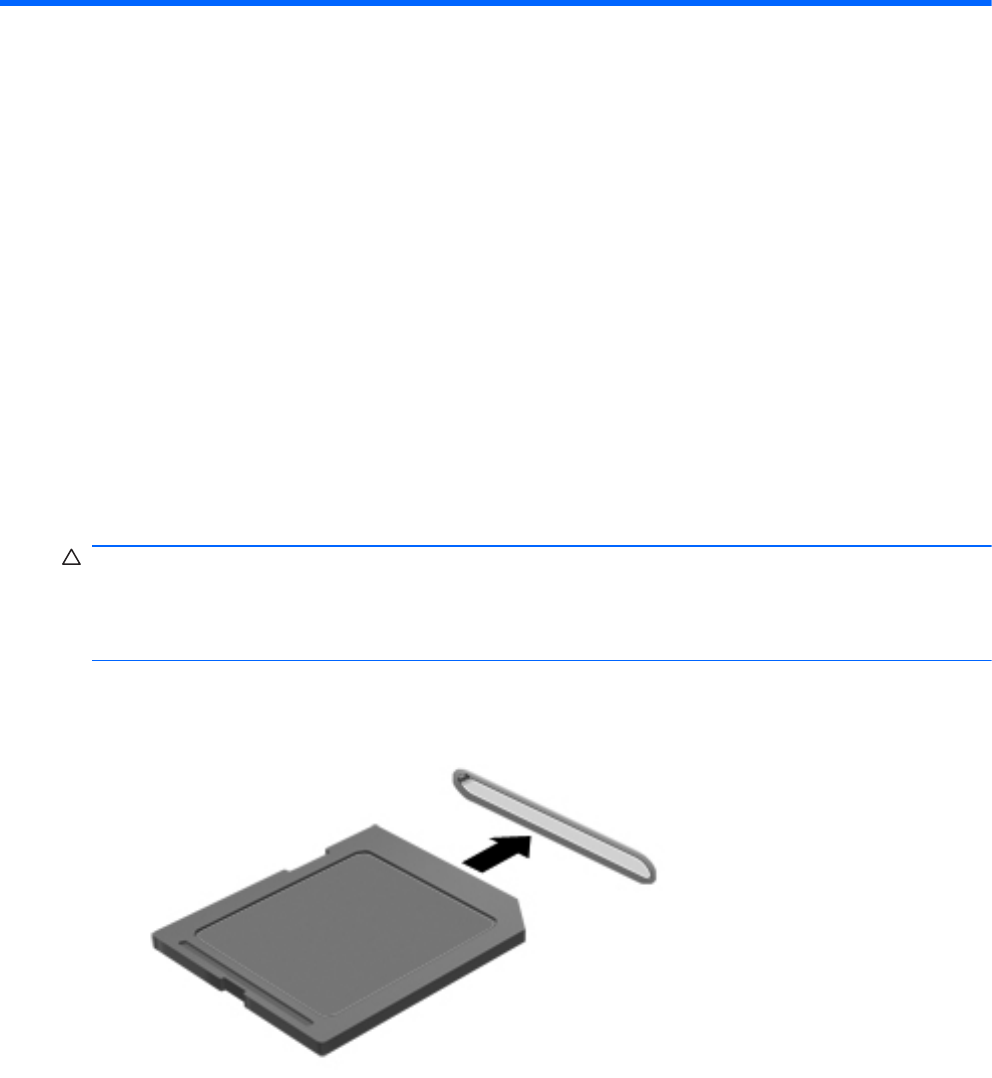
8 Digital cards
Optional digital cards provide secure data storage and convenient data sharing. These cards are
often used with digital media–equipped cameras and PDAs as well as with other devices.
The Digital Media Slot supports the following formats:
●Secure Digital High Capacity (SDHC) Memory Card (standard and large size)
●xD-Picture card
Inserting a digital card
CAUTION: To avoid damaging the digital card or the computer, do not insert any type of adapter
into the Digital Media Slot.
CAUTION: To prevent damage to the digital card connectors, use minimal force to insert a digital
card.
1. Hold the digital card label-side up, with the connectors toward the computer.
2. Insert the card into the Digital Media Slot, and then push in on the card until it is firmly seated.
You will hear a sound when the device has been detected, and a menu of options may be
displayed.
50 Chapter 8 Digital cards
Please review
chapter for
accuracy.
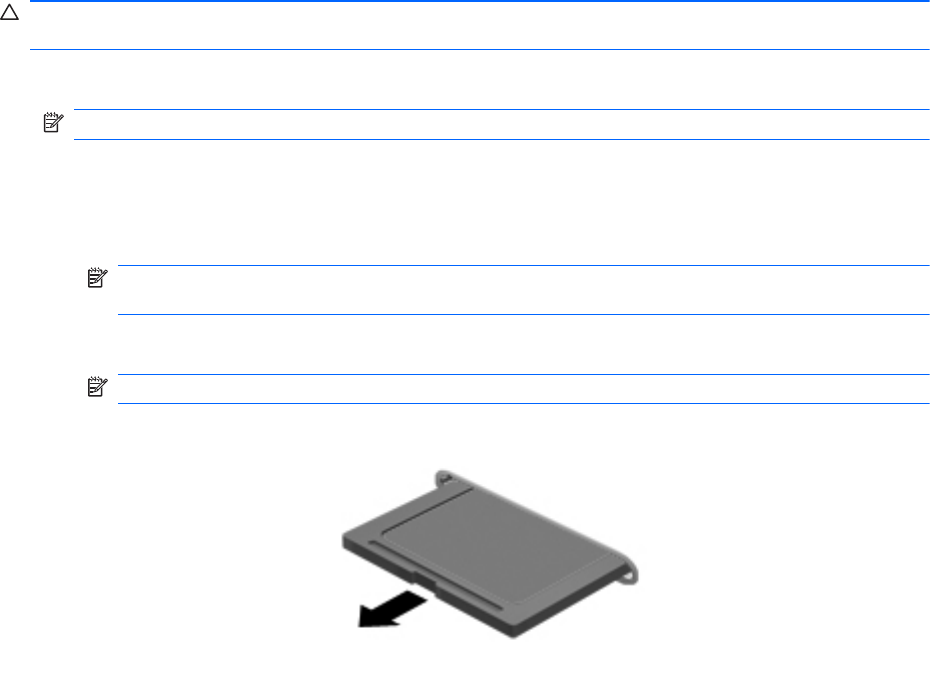
Removing a digital card
CAUTION: To prevent loss of information or an unresponsive system, use the following procedure
to safely remove the digital card.
1. Save your information and close all programs associated with the digital card.
NOTE: To stop a data transfer, tap Cancel in the operating system Copying window.
2. To remove a digital card:
a. Tap the Safely Remove Hardware and Eject Media icon in the notification area, at the far
right of the taskbar.
NOTE: To display the Safely Remove Hardware and Eject Media icon, tap the Show
hidden icons icon (the arrow at the left side of the notification area).
b. Tap the name of the digital card in the list.
NOTE: You are prompted that it is safe to remove the hardware device.
c. Press in on the digital card and then remove the digital card from the slot.
Removing a digital card 51
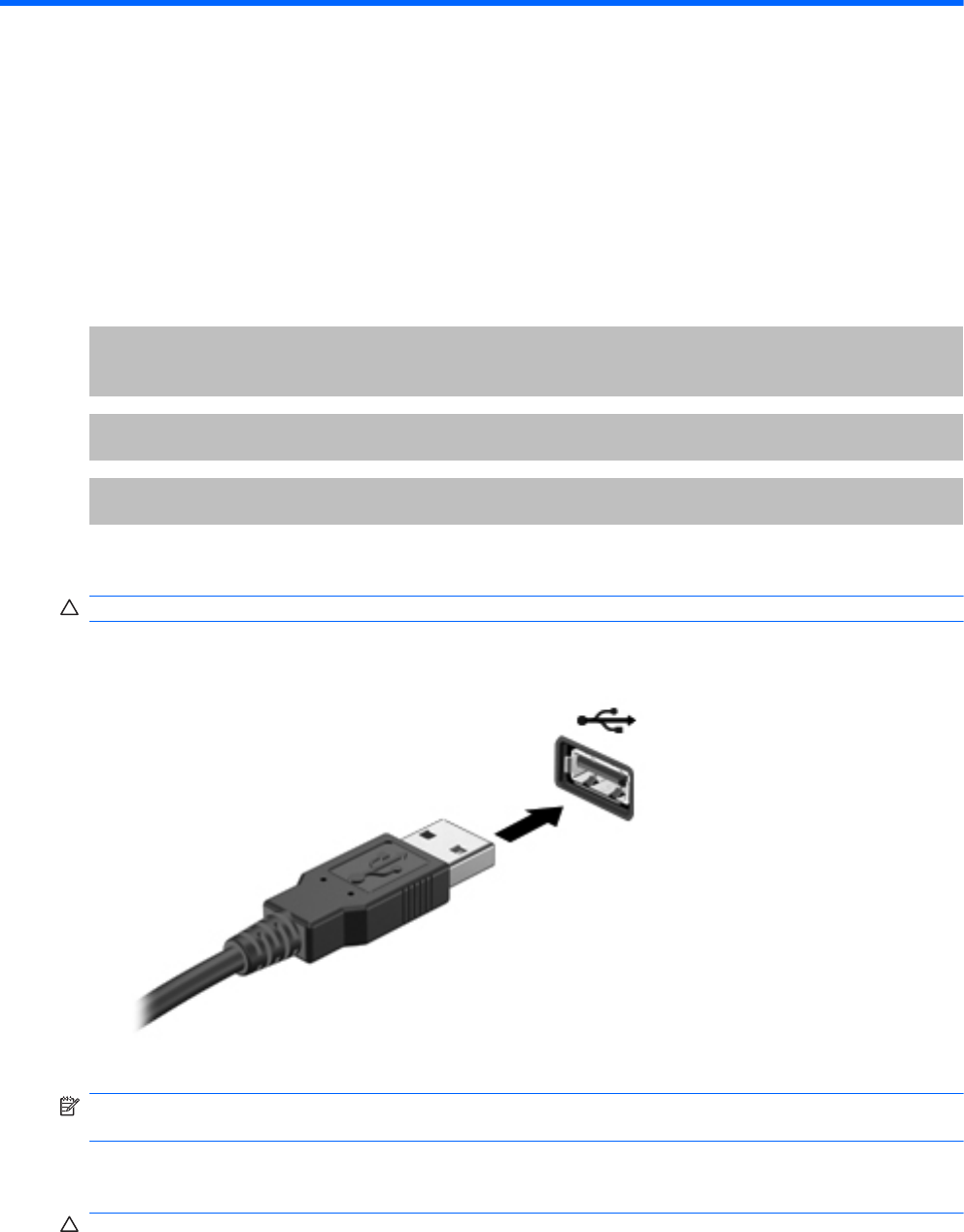
9USB devices
Using a USB device
Universal Serial Bus (USB) is a hardware interface that can be used to connect an optional external
device, such as a USB keyboard, mouse, drive, printer, scanner, or hub. Devices can be connected
to the system.
Some USB devices may require additional support software, which is usually included with the
device. For more information about device-specific software, refer to the manufacturer's instructions.
The computer has 3 USB ports, which support USB 1.0, USB 1.1, and USB 2.0 devices. An optional
USB hub provides additional USB ports that can be used with the computer.
Connecting a USB device
CAUTION: To prevent damage to a USB connector, use minimal force to connect a USB device.
▲To connect a USB device, connect the USB cable for the computer to the USB port.
You will hear a sound when the device has been detected.
NOTE: When you connect a USB device, you may see a message in the notification area to let you
know that the device is recognized by the system.
Removing a USB device
CAUTION: To prevent loss of information or an unresponsive system, use the following procedure
to safely remove a USB device.
52 Chapter 9 USB devices
Please review
chapter for
accuracy.

CAUTION: To prevent damage to a USB connector, do not pull on the cable to remove the USB
device.
To remove a USB device:
1. Tap the Safely Remove Hardware and Eject Media icon in the notification area, at the far right
of the taskbar.
NOTE: To display the Safely Remove Hardware and Eject Media icon, tap the Show hidden
icons icon (the arrow at the left of the notification area).
2. Tap the name of the device in the list.
NOTE: You are informed that it is safe to remove the device.
3. Remove the device.
Using a USB device 53

10 Pointing devices, touch screen, and
keyboard
54 Chapter 10 Pointing devices, touch screen, and keyboard
Please review for
accuracy,
especially the
touch screen
gestures and
keyboard sections.
Should action keys
and hotkeys
sections be
deleted?

Using pointing devices
NOTE: You can also connect an external USB mouse to one of the USB ports on the computer.
Setting pointing device preferences
Use Mouse Properties in Windows® to customize settings for pointing devices, such as button
configuration, click speed, and pointer options.
To access Mouse Properties, tap Start > Control Panel > Printers and Other Hardware > Mouse.
Using pointing devices 55
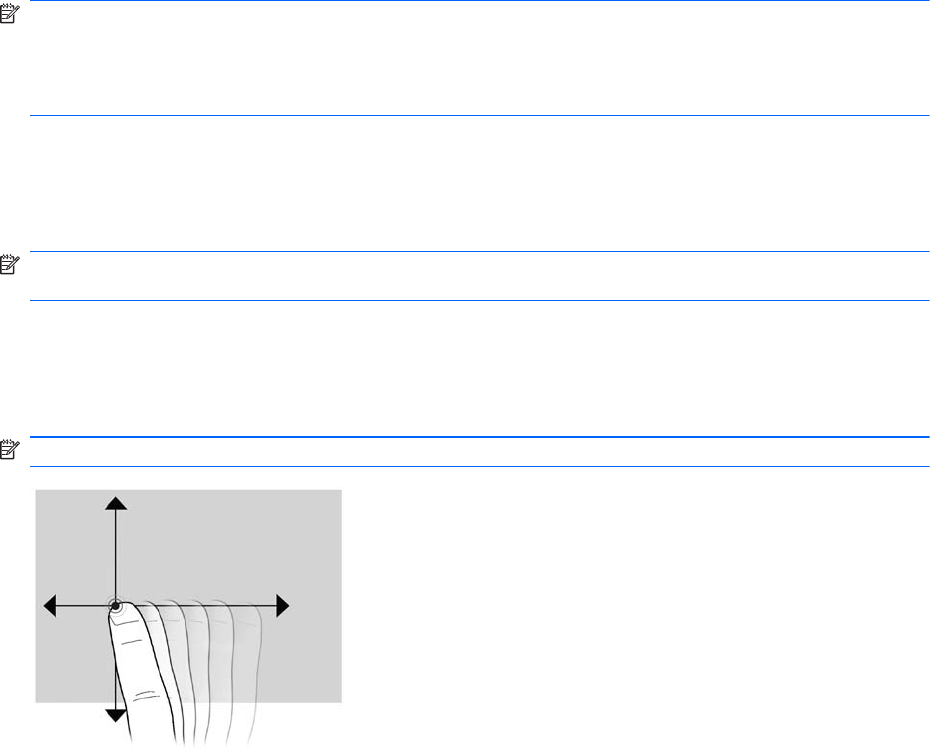
Using the touch screen
Using touch screen gestures
The computer allows you to use your fingers or the digitizer pen to perform certain actions on the
touch screen.
NOTE: The instructions in this section are based on the preferences set at the factory. To modify
settings for recognized taps and flicks, tap Start > Control Panel > Hardware and Sound > Pen
and Touch.
NOTE: Some gestures are not supported in all programs.
Tapping
Tap or double-tap an item on the screen as you would click or double-click with an external mouse.
Tap and hold an item to see the context menu.
NOTE: You must tap and hold your finger until the operating system draws a circle around the area
you are touching, and then the context menu appears.
Flicking
Touch the screen in a light, quick flicking motion up, down, left, or right to navigate through screens or
quickly scroll through documents.
NOTE: For the flick movement to work, a scrollbar must be present and in the active window.
Dragging
Press your finger on an item on the screen, and then move your finger to drag the item to a new
location. You can also use this motion to slowly scroll through documents.
56 Chapter 10 Pointing devices, touch screen, and keyboard
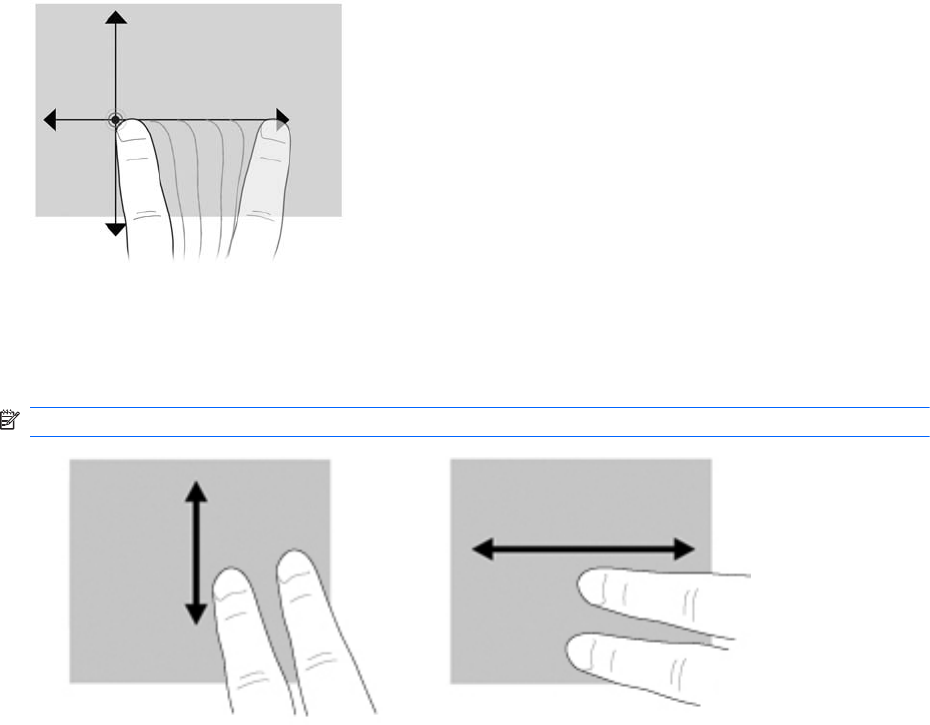
Scrolling
Scrolling is useful for moving up or down on a page or image. To scroll, place two fingers slightly
apart on the screen, and then drag them across the screen in an up, down, left, or right motion.
NOTE: Scrolling speed is controlled by finger speed.
Rotating
Rotating allows you rotate items such as photos and pages. To rotate, anchor your thumb on the
screen, and then move your forefinger in a semicircular motion around your thumb.
Using the touch screen 57
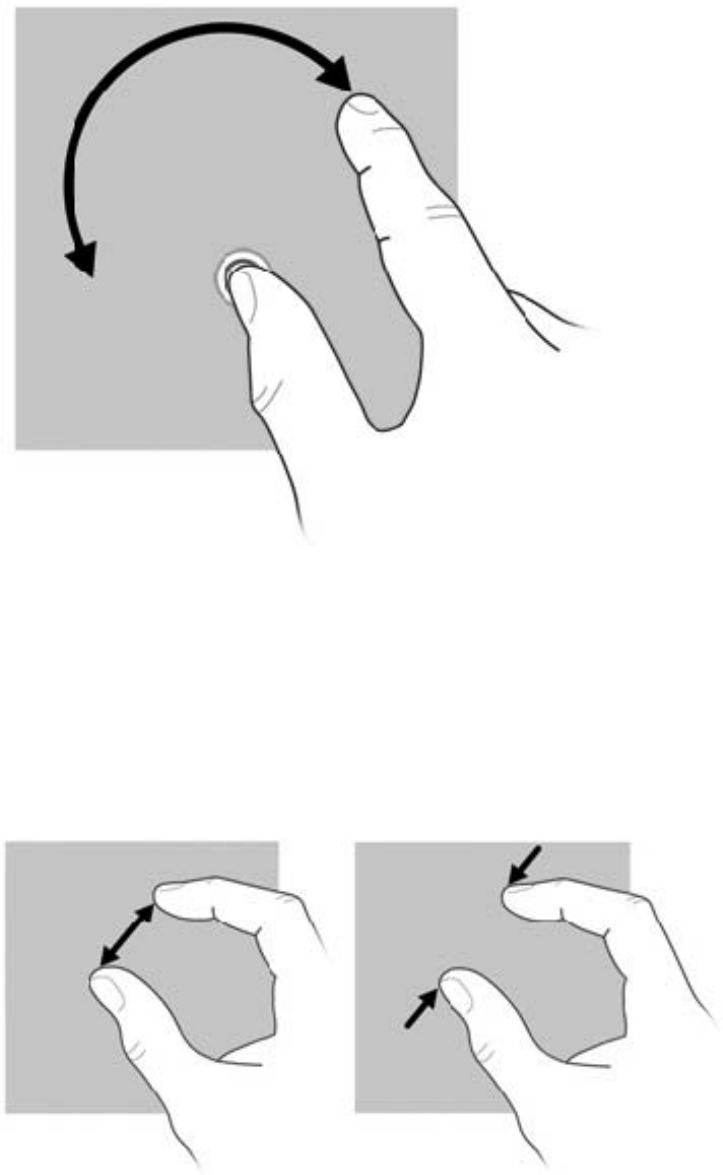
Pinching
Pinching allows you to zoom in or out on items such as PDFs, images, and photos.
To pinch:
●Zoom out by holding two fingers apart on the screen, and then pull the fingers together to
decrease an object's size.
●Zoom in by holding two fingers together on the screen, and then pull the fingers apart to
increase an object's size.
58 Chapter 10 Pointing devices, touch screen, and keyboard
Setting touch screen preferences
▲To set preferences for visual feedback, tap Start > Control Panel > Hardware and Sound >
Pen and Touch. These preferences are specific to the touch screen and the computer.
▲To set preferences for left-handed or right-handed users, tap Start > Control Panel > Hardware
and Sound > Tablet PC Settings > Other tab. These preferences are specific to the touch
screen and the computer.
▲To set pointing device preferences such as pointer speed, tap speed, and mouse trails, tap Start
> Devices and Printers. Then, tap the device representing your computer, and tap Mouse
settings. These preferences apply to any pointing device in the system.
To change or test tap settings:
1. Tap Start > Control Panel > Hardware and Sound> Pen and Touch > Pen Options tab.
2. Under Pen Actions, tap the action, and then tap Settings.
3. After making any changes or testing the settings, tap OK.
To change or create flick assignments:
1. Tap Start > Control Panel > Hardware and Sound> Pen and Touch > Flicks tab.
2. Tap Navigational flicks and editing flicks, and then tap Customize.
3. Follow the on-screen instructions to change or create a flick assignment.
4. Tap OK.
Using the touch screen 59
Navigating the keyboard utility
When you set up your HP TouchSmart Slate Edition, occasionally you will need to enter data into a
data field. This is required when you set up a wireless network configuration, a weather reporting
location, or when you access user accounts on Internet sites (such as Snapfish and Facebook). Your
Slate has a keyboard utility that appears when you need to enter such information into data fields.
1. Tap in the first data field to display the keyboard.
You can also access the keyboard by dragging it from the left side of the screen, or by pressing
the Keyboard button (next to the Home button on the top edge of the Slate).
2. Tap each character, continuing until you have spelled out the name or word that you are
entering into the data field.
3. Tap Enter on the keyboard, and then tap OK.
4. Tap the left arrow, right arrow, Continue button, or Back button to move among any other data
fields. Select Continue, and then tap OK when you have finished entering data in all required
fields.
60 Chapter 10 Pointing devices, touch screen, and keyboard
image of virtual
keyboard needed

Using the action keys
Action keys are customized actions that are assigned to specific keys at the top of the keyboard.
To use an action key, press and hold this key to activate the assigned action.
NOTE: Depending on the application you are using, pressing fn and one of the action keys will open
a specific shortcut menu within that application.
NOTE: The action key feature is enabled at the factory. You can disable this feature in Setup Utility
(BIOS) and revert back to pressing the fn key and one of the action keys to activate the assigned
action.
Icon Action Description
Help and Support Opens Help and Support, which provides information about your Windows operating
system and computer, answers to questions and tutorials, and updates to your
computer.
Help and Support also provides automated troubleshooting and links to support
specialists.
Screen brightness down Decreases the screen brightness level incrementally when you hold down this key.
Screen brightness up Increases the screen brightness level incrementally when you hold down this key.
Switch screen image Switches the screen image among display devices connected to the system. For
example, if a monitor is connected to the computer, pressing this key alternates the
screen image from computer display to monitor display to simultaneous display on
both the computer and the monitor.
Most external monitors receive video information from the computer using the
external VGA video standard. The switch screen image key can also alternate
images among other devices that are receiving video information from the computer.
Previous track Plays the previous track of an audio CD or the previous section of a DVD or a BD.
Play/Pause Plays, pauses, or resumes an audio CD, a DVD, or a BD.
●If an audio CD, a DVD, or a BD is not playing, press this key to begin or resume
the play.
●If an audio CD, a DVD, or a BD is playing, press this key to pause the play.
Stop Stops audio or video playback of a CD, a DVD, or a BD.
Next track Plays the next track of an audio CD or the next section of a DVD or a BD.
Volume down Decreases speaker sound incrementally when you hold down this key.
Volume up Increases speaker sound incrementally when you hold down this key.
Mute Mutes or restores speaker sound.
Using the action keys 61
Should this section
be deleted, or does
Akashi have
equivalent keys on
virtual keyboard?

Icon Action Description
Wireless Turns the wireless feature on or off.
NOTE: This key does not establish a wireless connection. To establish a wireless
connection, a wireless network must be set up.
prt sc Print screen Takes a snapshot or picture of your computer screen and copies it to the clipboard.
62 Chapter 10 Pointing devices, touch screen, and keyboard

Using the hotkeys
Hotkeys are combinations of the fn key (1) and either the esc key (2) or one of the arrow keys (3).
Hotkey Description
Display system information. fn+esc Displays information about system hardware components and
the system BIOS version number.
Scroll up. fn+up arrow Scrolls the page up.
Scroll down. fn+down arrow Scrolls the page down.
Go home. fn+left arrow Returns the cursor to the beginning of the line where the
cursor is located or returns to the beginning of the document.
Go to the end. fn+right arrow Places the cursor at the end of the line or scrolls to the end of
the document.
To use a hotkey command, follow either of these steps:
●Briefly press the fn key, and then briefly press the second key of the hotkey command.
– or –
●Press and hold down the fn key, briefly press the second key of the hotkey command, and then
release both keys at the same time.
Using the hotkeys 63
Should this section
be deleted, or does
Akashi have
equivalent keys on
virtual keyboard?

11 Drives
Identifying installed drives
To view the drives installed on the computer, tap Start > Computer.
Handling drives
Drives are fragile computer components that must be handled with care. Refer to the following
cautions before handling drives. Additional cautions are included with the procedures to which they
apply.
CAUTION: To reduce the risk of damage to the computer, damage to a drive, or loss of information,
observe these precautions:
Before you move a computer that is connected to an external hard drive, initiate Sleep and allow the
screen to clear, or properly disconnect the external hard drive.
Before handling a drive, discharge static electricity by touching the unpainted metal surface of the
drive.
Do not touch the connector pins on a removable drive or on the computer.
Handle a drive carefully; do not drop a drive or place items on it.
Before removing or inserting a drive, shut down the computer. If you are unsure whether the
computer is off, in the Sleep state, or in Hibernation, turn the computer on and then shut it down
through the operating system.
Do not use excessive force when inserting a drive into a drive bay.
When the battery is the only source of power, be sure that the battery is sufficiently charged before
writing to media.
Avoid exposing a drive to temperature or humidity extremes.
Avoid exposing a drive to liquids. Do not spray the drive with cleaning products.
Remove media from a drive before removing the drive from the drive bay, or traveling with, shipping,
or storing a drive.
If a drive must be mailed, place the drive in a bubble-pack mailer or other suitable protective
packaging and label the package “FRAGILE.”
Avoid exposing a drive to magnetic fields. Security devices with magnetic fields include airport walk-
through devices and security wands. The airport security devices that check carry-on luggage, such
as conveyor belts, use X-rays instead of magnetism and will not damage a drive.
64 Chapter 11 Drives
Please review
chapter for
accuracy.

Using external drives
Removable external drives expand your options for storing and accessing information.
USB drives include the following types:
●1.44-megabyte diskette drive
●Hard drive module (a hard drive with an adapter attached)
●DVD-ROM Drive
●DVD/CD-RW Combo Drive
●DVD+RW/R and CD-RW Combo Drive
●DVD±RW/R and CD-RW Combo Drive
Using optional external devices
NOTE: For more information about required software and drivers, or to learn which device port to
use, refer to the manufacturer's instructions.
To connect an external device:
CAUTION: To reduce the risk of damage to the equipment when connecting a powered device, be
sure that the computer is turned off and the AC power cord is unplugged.
1. Connect the device.
2. If you are connecting a powered device, plug the device power cord into a grounded AC outlet.
3. Turn on the computer.
To disconnect an unpowered external device, turn off the computer, and then disconnect it. To
disconnect a powered external device, turn off the computer, disconnect it, and then unplug the AC
power cord.
Using external drives 65

12 Updating software
Updated versions of the software provided with your computer may be available on the HP Web site.
Most software and BIOS updates on the HP Web site are packaged in compressed files called
SoftPaqs.
Some download packages contain a file named Readme.txt, which contains information regarding
installing and troubleshooting the file.
To update the software, follow these steps, which are explained in the remainder of this guide:
1. Identify your computer model, product category, and series or family. Prepare for a system BIOS
update by identifying the BIOS version currently installed on the computer.
If your computer is connected to a network, consult the network administrator before installing
any software updates, especially system BIOS updates.
NOTE: The computer system BIOS is stored on the system ROM. The BIOS initializes the
operating system, determines how the computer will interact with the hardware devices, and
provides for data transfer among hardware devices, including the time and date.
2. Access the updates on the HP Web site at http://www.hp.com.
3. Install the updates.
66 Chapter 12 Updating software
Please review for
accuracy --
especially BIOS
updates section

Updating the BIOS
To update the BIOS, first determine what BIOS version you currently have and then download and
install the new BIOS.
Determining the BIOS version
To determine whether available BIOS updates contain later BIOS versions than those currently
installed on the computer, you need to know the version of the system BIOS currently installed.
BIOS version information (also known as ROM date and System BIOS) can be displayed by opening
Setup Utility.
To display the BIOS information:
1. Open Setup Utility by turning on or restarting the computer, and then pressing f10 while the “F10
= BIOS Setup Options” message is displayed in the lower-left corner of the screen.
2. If Setup Utility does not open with the system information displayed, use the arrow keys to tap
the Main menu.
When the Main menu is selected, BIOS and other system information is displayed.
3. To exit Setup Utility, use the arrow keys to select Exit > Exit Discarding Changes, and then
press enter.
Downloading a BIOS update
CAUTION: To prevent damage to the computer or an unsuccessful installation, download and
install a BIOS update only when the computer is connected to reliable external power using the AC
adapter. Do not download or install a BIOS update while the computer is running on battery power or
connected to an optional power source. During the download and installation, follow these
instructions:
Do not disconnect power from the computer by unplugging the power cord from the AC outlet.
Do not shut down the computer or initiate Sleep or Hibernation.
Do not insert, remove, connect, or disconnect any device, cable, or cord.
To download a BIOS update:
1. Access the page on the HP Web site that provides software for your computer:
Tap Start > Help and Support, and then select the software and drivers update.
2. Follow the instructions on the screen to identify your computer and access the BIOS update you
want to download.
3. At the download area, follow these steps:
a. Identify the BIOS update that is later than the BIOS version currently installed on your
computer. Make a note of the date, name, or other identifier. You may need this information
to locate the update later, after it has been downloaded to your hard drive.
b. Follow the instructions on the screen to download your selection to the hard drive.
Updating the BIOS 67

Make a note of the path to the location on your hard drive where the BIOS update is to be
downloaded. You will need to access this path when you are ready to install the update.
NOTE: If you connect your computer to a network, consult the network administrator before
installing any software updates, especially system BIOS updates.
BIOS installation procedures vary. Follow any instructions that are displayed on the screen after the
download is complete. If no instructions are displayed, follow these steps:
1. Open Windows Explorer by tapping Start > Computer.
2. Double-tap your hard drive designation. The hard drive designation is typically Local Disk (C:).
3. Using the hard drive path you recorded earlier, open the folder on your hard drive that contains
the update.
4. Double-tap the file that has an .exe extension (for example, filename.exe).
The BIOS installation begins.
5. Complete the installation by following the instructions on the screen.
NOTE: After a message on the screen reports a successful installation, you can delete the
downloaded file from your hard drive.
68 Chapter 12 Updating software

Updating programs and drivers
To download and install software other than a BIOS update, follow these steps:
1. Access the page on the HP Web site that provides software for your computer:
Tap Start > Help and Support, and then tap the software and drivers update.
2. Follow the instructions on the screen to find the software you want to update.
3. At the download area, tap the software you want to download and follow the instructions on the
screen.
NOTE: Make a note of the path to the location on your hard drive where the software is to be
downloaded. You will need to access this path when you are ready to install the software.
4. When the download is complete, open Windows Explorer by tapping Start > Computer.
5. Double-tap your hard drive designation. The hard drive designation is typically Local Disk (C:).
6. Using the hard drive path you recorded earlier, open the folder on your hard drive that contains
the update.
7. Double-tap the file that has an .exe extension (for example, filename.exe).
The installation begins.
8. Complete the installation by following the instructions on the screen.
NOTE: After a message on the screen reports a successful installation, you can delete the
downloaded file from your hard drive.
Updating programs and drivers 69

13 Setup Utility
Starting Setup Utility
Setup Utility is a ROM-based information and customization utility that can be used even when your
Windows operating system is not working.
The utility reports information about the computer and provides settings for startup, security, and
other preferences.
To start Setup Utility:
▲Open Setup Utility by turning on or restarting the computer, and then pressing f10 while the “F10
= BIOS Setup Options” message is displayed in the lower-left corner of the screen.
Using Setup Utility
Changing the language of Setup Utility
The following procedure explains how to change the language of Setup Utility. If Setup Utility is not
already running, begin at step 1. If Setup Utility is already running, begin at step 2.
1. Open Setup Utility by turning on or restarting the computer, and then pressing f10 while the “F10
= BIOS Setup Options” message is displayed in the lower-left corner of the screen.
2. Use the arrow keys to select System Configuration > Language, and then press enter.
3. Use the arrow keys to select a language, and then press enter.
4. When a confirmation prompt with your language selected is displayed, press enter.
5. To save your change and exit Setup Utility, use the arrow keys to select Exit > Exit Saving
Changes, and then press enter.
Your change goes into effect immediately.
Navigating and selecting in Setup Utility
Because Setup Utility is not Windows based, it does not support the touch screen. Navigation and
selection are by keystroke.
●To choose a menu or a menu item, use the arrow keys.
●To choose an item in a list or to toggle a field, for example an Enable/Disable field, use either the
arrow keys or f5 or f6.
70 Chapter 13 Setup Utility
Please review and
provide corrections
for how to access
Setup Utility and
Setup Menus

●To select an item, press enter.
●To close a text box or return to the menu display, press esc.
●To display additional navigation and selection information while Setup Utility is open, press f1.
Displaying system information
The following procedure explains how to display system information in Setup Utility. If Setup Utility is
not open, begin at step 1. If Setup Utility is open, begin at step 2.
1. Open Setup Utility by turning on or restarting the computer, and then pressing f10 while the “F10
= BIOS Setup Options” message is displayed in the lower-left corner of the screen.
2. Tap the Main menu. System information such as the system time and date, and identification
information about the computer is displayed.
3. To exit Setup Utility without changing any settings, use the arrow keys to select Exit > Exit
Discarding Changes, and then press enter.
Restoring default settings in Setup Utility
The following procedure explains how to restore the Setup Utility default settings. If Setup Utility is not
already running, begin at step 1. If Setup Utility is already running, begin at step 2.
1. Open Setup Utility by turning on or restarting the computer, and then pressing f10 while the “F10
= BIOS Setup Options” message is displayed in the lower-left corner of the screen.
2. Use the arrow keys to select Exit > Load Setup Defaults, and then press enter.
3. When the Setup Confirmation is displayed, press enter.
4. To save your change and exit Setup Utility, use the arrow keys to select Exit > Exit Saving
Changes, and then press enter.
The Setup Utility default settings go into effect when the computer restarts.
NOTE: Your password, security, and language settings are not changed when you restore the
factory default settings.
Exiting Setup Utility
You can exit Setup Utility with or without saving changes.
●To exit Setup Utility and save your changes from the current session:
If the Setup Utility menus are not visible, press esc to return to the menu display. Then use the
arrow keys to select Exit > Exit Saving Changes, and then press enter.
●To exit Setup Utility without saving your changes from the current session:
If the Setup Utility menus are not visible, press esc to return to the menu display. Then use the
arrow keys to select Exit > Exit Discarding Changes, and then press enter.
After either choice, the computer restarts in Windows.
Using Setup Utility 71

Setup Utility menus
The menu tables in this section provide an overview of the Setup Utility options.
NOTE: Some of the Setup Utility menu items listed in this chapter may not be supported by your
computer.
Main menu
Tap To do this
System information ●View and change the system time and date.
●View identification information about the computer.
●View specification information about the processor, memory size,
and system BIOS.
Security menu
Tap To do this
Administrator password Enter, change, or delete an administrator password.
Power-On Password Enter, change, or delete a power-on password.
System Configuration menu
Tap To do this
Language Support Change the Setup Utility language.
Processor C4 State Enable/disable the processor C4 sleep state.
Boot Options Set the following boot options:
●f10 and f12 Delay (sec.)―Set the delay for the f10 and f12
functions of Setup Utility in intervals of 5 seconds each (0, 5, 10,
15, 20).
●HP QuickWeb—Enable/disable the QuickWeb Boot menu in Setup
Utility.
●Internal Network Adapter boot―Enable/disable boot from Internal
Network Adapter.
●Boot Device Priority―Set the boot device priority for:
◦Internal hard drive (select models only)
◦USB Floppy
◦USB CD/DVD ROM Drive
◦USB flash drive
◦USB Hard drive
72 Chapter 13 Setup Utility

Tap To do this
◦USB Card Reader
◦Network adapter
NOTE: Only the devices attached to the system appear in
the boot order menu.
Diagnostics menu
Tap To do this
Hard Disk Self Test (select models only) Run a comprehensive self-test on the hard drive.
Memory Test Run a diagnostic test on the system memory.
Setup Utility menus 73

Index
A
AC adapter
connecting 18
action keys
adjusting volume 61
audio CD, DVD, or BD
controls 61
decrease screen
brightness 61
Help and Support 61
increase screen brightness 61
muting speaker sound 61
switching screen image 61
using 61
wireless 62
Add aplications icon, identifying 4
Add URL icon, identifying 4
administrator password
creating 45
entering 45
managing 45
airport security devices 64
antennas 13
audio devices, connecting
external 39
audio functions, checking 39
audio-in (microphone) jack 11, 37
audio-out (headphone)
jack 11, 37
B
battery
calibrating 21
charging 19, 21
discharging 20
low battery levels 20
recharging 23
battery light 19, 20
battery power 18
BIOS, updating 67
Bluetooth device 26
Bluetooth icon, identifying 3
boot options 72
boot order 72
button
volume down 11
volume up 11
buttons
home 10
keyboard 10
C
cables
USB 52
calibrating battery 21
CD drive 65
changing Setup Utility
language 70
charging batteries 19, 21
checking audio functions 39
components
bottom 13
display 12
front 10
left-side 12
rear 10
right-side 11
connecting to a WLAN 30
Connection Manager icon 26
connection, external power 18
connector, power 10
Content area controls 4
corporate WLAN connection 30
critical battery level 21
D
Details icon, identifying 4
Diagnostics menu 73
digital card
inserting 50
removing 51
diskette drive 65
display image, switching 61
displaying system information 71
dragging touch screen
gesture 56
drive media 15
drives
diskette 65
external 65
hard 65
optical 65
drives, boot order 72
DVD drive 65
E
earbuds 11, 37
encryption 30
End hotkey 63
entering a power-on
password 46
entering an administrator
password 45
exiting Setup Utility 71
external audio devices,
connecting 39
external drive 65
F
firewall 30
flicking touch screen gesture 56
flicks
changing assignments 59
creating assignments 59
fn key, identifying 63
Full screen icon, identifying 3
74 Index
H
hard drive self test 73
hard drive, external 65
hardware, identifying 10
headphone (audio-out)
jack 11, 37
headphones 11, 37
Help and Support key 61
Help icon, identifying 3
Hibernation
exiting 16
initiated during critical battery
level 21
initiating 16
Home hotkey 63
Home screen
navigating 3
hotkeys
description 63
display system information 63
End 63
Home 63
page down 63
page up 63
using 63
HP Connection Manager
software 27
HP Mobile Broadband Module 32
HP Mobile Broadband,
disabled 32
hubs 52
I
icons
Connection Manager 26
network 26
wireless 26
Internet connection setup 29
J
jacks
audio-in (microphone) 11, 37
audio-out
(headphone) 11, 37
K
keyboard hotkeys, identifying 63
keyboard utility
navigating 60
L
label 11
labels
Microsoft Certificate of
Authenticity 14
regulatory 14
service tag 14
language support 72
low battery level 20
M
Main menu 72
managing a power-on
password 46
managing an administrator
password 45
media controls, keys 61
memory test 73
microphone (audio-in) jack 11, 37
mouse, external
setting preferences 55
multimedia components,
identifying 36
multimedia software
installing 38
using 38
mute key
identifying 61
N
navigating in Setup Utility 70
network icon 26
O
operating system 24
optical drive 65
P
page down hotkey 63
page up hotkey 63
passwords
administrator 45
power-on 45
set in Setup Utility 44
set in Windows 44
pinching touch screen gesture 58
pointing devices
setting preferences 55
ports
USB 10, 52
power
connecting 18
Power icon, identifying 3, 4
power-on password
creating 46
entering 46
managing 46
Processor C4 State 72
product name and number,
computer 14
programs, updating 69
public WLAN connection 30
Q
QuickWeb
Setup Utility 72
R
readable media 15
regulatory information
HP Mobile Broadband Module
serial number 14
regulatory label 14
wireless 14
restoring default settings 71
rotating touch screen gesture 57
S
screen brightness keys 61
screen image, switching 61
scrolling touch screen gesture 57
Search icon, identifying 3
Security menu 72
security, wireless 29
selecting in Setup Utility 70
serial number, computer 14
service tag 14
Settings icon, identifying 4
setup of WLAN 29
Setup Utility, passwords set in 44
setup, computer 10
shut down 24
SIM
inserting 32
removing 33
Slate Camera, using 6
Slate Home
using 5
Slate Music, using 7
Slate Photo, using 8
Slate Video, using 9
Index 75
Sleep
exiting 15
initiating 15
slots
SIM 12
software
HP Connection Manager 27
installing 38
multimedia 38
Slate Music 38
Slate Video 38
speakers, identifying 37
System Configuration menu 72
system information 72
system information hotkey 63
T
tapping touch screen gesture 56
taps
changing settings 59
testing 59
Toolbar controls 4
Top bar controls 3
touch screen
performing screen actions 56
preferences 59
using 56
touch screen gestures
dragging 56
flicking 56
pinching 58
rotating 57
scrolling 57
tapping 56
zooming 58
Trash can icon, identifying 4
turning off the computer 24
U
unresponsive system 24
USB cable, connecting 52
USB devices
connecting 52
description 52
removing 52
USB hubs 52
USB ports, identifying 52
V
vents 10
volume icon, identifying 3
volume keys, identifying 61
volume, adjusting 37
W
webcam, identifying 12, 13, 36
WiFi icon, identifying 3
Windows security button,
identifying 12
Windows, passwords set in 44
wireless action key, identifying 27
wireless antennas 13
wireless controls
button 27
operating system 27
wireless icon 26
wireless key
identifying 62
wireless light, identifying 27
wireless network (WLAN)
connecting 30
corporate WLAN
connection 30
equipment needed 29
functional range 31
public WLAN connection 30
security 29
wireless network, connecting 26
WLAN antennas, identifying 14
WLAN device 26
writable media 15
WWAN antennas, identifying 13
Z
zooming screen gesture 58
76 Index
